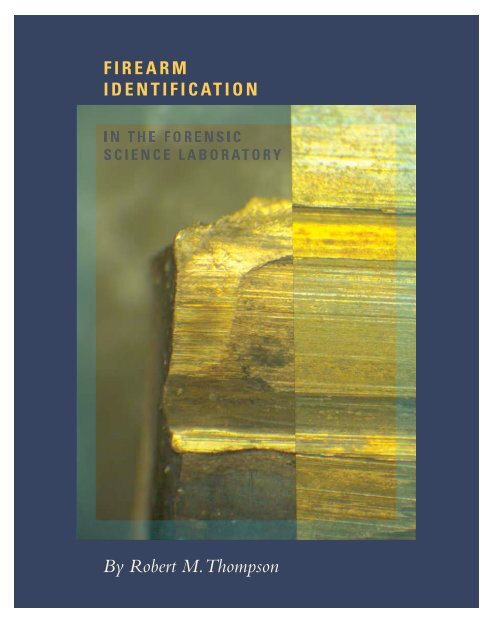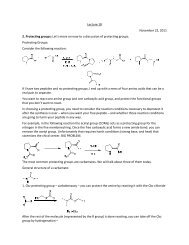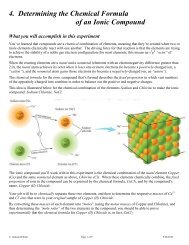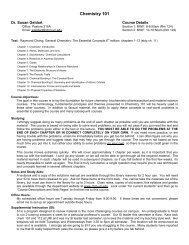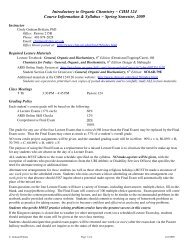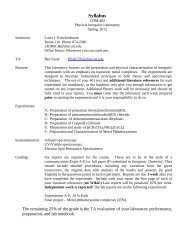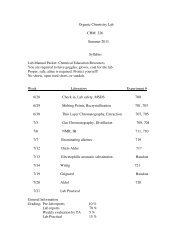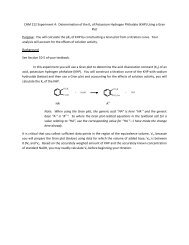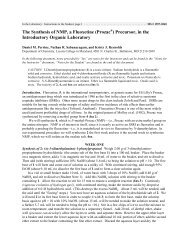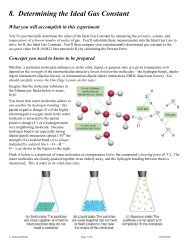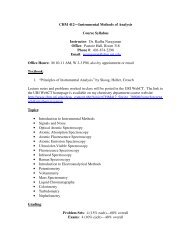Firearm Identification in the Forensic Science Laboratory
Firearm Identification in the Forensic Science Laboratory
Firearm Identification in the Forensic Science Laboratory
Create successful ePaper yourself
Turn your PDF publications into a flip-book with our unique Google optimized e-Paper software.
F I R E A R M<br />
I D E N T I F I C AT I O N<br />
By Robert M. Thompson
Christopher Chiles<br />
President<br />
Scott Burns<br />
Executive Director<br />
John Wilk<strong>in</strong>son<br />
Program Manager, Gun Violence Prosecution Program<br />
2010 by <strong>the</strong> National District Attorneys Association<br />
This project was supported by <strong>the</strong> Bureau of Justice Assistance under grant number<br />
2008-MU-MU-K004 awarded to <strong>the</strong> National District Attorneys Association. The Bureau<br />
of Justice Assistance is a component of <strong>the</strong> U.S. Department of Justice’s Office of Justice<br />
Programs, which also <strong>in</strong>cludes <strong>the</strong> Bureau of Justice Statistics, <strong>the</strong> National Institute<br />
of Justice, <strong>the</strong> office of Juvenile Justice and Del<strong>in</strong>quency Prevention, and <strong>the</strong> Office<br />
for Victims of Crime. Po<strong>in</strong>ts of view or op<strong>in</strong>ions <strong>in</strong> this document do not necessarily represent<br />
<strong>the</strong> official positions or policies of <strong>the</strong> U.S. Department of Justice of <strong>the</strong> National<br />
District Attorneys Association.<br />
GUN VIOLENCE PROSECUTION PROGRAM<br />
A program of <strong>the</strong> National District Attorneys Association<br />
44 Canal Center Plaza, Suite 110<br />
Alexandria, VA 22314<br />
www.ndaa.org
F I R E A R M<br />
I D E N T I F I C AT I O N<br />
I N T H E F O R E N S I C<br />
S C I E N C E L A B O R AT O R Y<br />
By Robert M. Thompson<br />
Program Manager for <strong>Forensic</strong> Data Systems<br />
Office of Law Enforcement Standards<br />
National Institute of Standards and Technology
C O N T E N T S<br />
7 Introduction<br />
9 The <strong>Science</strong> of <strong>Firearm</strong> <strong>Identification</strong><br />
12 The Production of <strong>Firearm</strong> Toolmarks on <strong>the</strong> Fired Cartridge<br />
26 The Exam<strong>in</strong>ation Process and Trial Preparation<br />
31 Appendix and Glossary
I N T RO D U C T I O N<br />
F O R A P RO S E C U TO R to be successful, he<br />
or she must be cognizant of <strong>the</strong> expectations of<br />
today’s jury. Thanks to <strong>the</strong> modern electronic<br />
media, use of <strong>the</strong> forensic sciences has caught<br />
<strong>the</strong> imag<strong>in</strong>ation of <strong>the</strong> public, and <strong>the</strong> potential<br />
jury pool has demonstrated that it has certa<strong>in</strong><br />
expectations when a case is brought before it.<br />
No matter how fantastic or erroneous <strong>the</strong>se expectations<br />
are, practitioners <strong>in</strong> law enforcement<br />
and experts <strong>in</strong> <strong>the</strong> forensic sciences have to deal<br />
with <strong>the</strong>m <strong>in</strong> a forthright manner. The best<br />
strategy is for <strong>the</strong> prosecutor to be well acqua<strong>in</strong>ted<br />
with <strong>the</strong> capabilities and limits of <strong>the</strong><br />
forensic science discipl<strong>in</strong>es that may be <strong>the</strong><br />
l<strong>in</strong>chp<strong>in</strong> <strong>in</strong> <strong>the</strong> <strong>in</strong>vestigation and, more importantly,<br />
<strong>in</strong> <strong>the</strong> prosecution of a defendant at trial.<br />
This monograph serves to <strong>in</strong>troduce <strong>the</strong><br />
prosecutor to <strong>the</strong> pr<strong>in</strong>cipal elements of one of<br />
<strong>the</strong> forensic specialties, <strong>the</strong> science of “firearm<br />
and toolmark identification.” Many of <strong>the</strong><br />
words and terms pr<strong>in</strong>ted <strong>in</strong> bold <strong>in</strong> <strong>the</strong> text are<br />
def<strong>in</strong>ed <strong>in</strong> <strong>the</strong> glossary. The monograph provides<br />
an <strong>in</strong>troductory discussion of <strong>the</strong> specialty<br />
of toolmark identification when <strong>the</strong> tool <strong>in</strong>volved<br />
is a firearm. The tool surfaces represented<br />
here <strong>in</strong>volve one or more of <strong>the</strong><br />
follow<strong>in</strong>g: <strong>the</strong> <strong>in</strong>terior of <strong>the</strong> barrel, <strong>the</strong> chamber,<br />
parts of <strong>the</strong> action, and ammunition magaz<strong>in</strong>e<br />
components. These surfaces of <strong>the</strong> firearm<br />
can produce toolmarks on fired and unfired<br />
ammunition components. The forensic scientist<br />
views a “tool” as <strong>the</strong> harder of two objects<br />
where <strong>the</strong> surface of <strong>the</strong> harder “tool” produces<br />
toolmarks on a softer material. For example, <strong>the</strong><br />
tool surface of <strong>the</strong> hard barrel <strong>in</strong>terior leaves<br />
toolmarks on <strong>the</strong> softer metal of <strong>the</strong> fired bullet.<br />
Ano<strong>the</strong>r example is when a cartridge is fired<br />
<strong>in</strong> a firearm. The softer metal used <strong>in</strong> <strong>the</strong> cartridge<br />
case construction may show toolmarks<br />
caused by <strong>the</strong> <strong>in</strong>terior chamber and action surfaces<br />
com<strong>in</strong>g <strong>in</strong> contact with <strong>the</strong> cartridge case.<br />
The action is <strong>the</strong> firearm’s load<strong>in</strong>g and fir<strong>in</strong>g<br />
mechanism.<br />
For <strong>the</strong>re to be a potential for toolmark identification,<br />
<strong>the</strong> tool work<strong>in</strong>g surface (1) must<br />
have <strong>in</strong>dividuality, and (2) <strong>the</strong> toolmarks must<br />
be reproducible for comparisons. If it is determ<strong>in</strong>ed<br />
that <strong>the</strong> <strong>in</strong>dividual character of <strong>the</strong> tool<br />
work<strong>in</strong>g surface is reproduced <strong>in</strong> <strong>the</strong> toolmarks<br />
from repetitive mark<strong>in</strong>gs, an exam<strong>in</strong>er may be<br />
able to make an identification <strong>in</strong> later comparisons.<br />
Editor’s Note: Robert M. Thompson is <strong>the</strong> program manager for <strong>Forensic</strong> Data Systems <strong>in</strong> <strong>the</strong> Office of Law Enforcement Standards<br />
at <strong>the</strong> National Institute of Standards and Technology (NIST). Prior to work<strong>in</strong>g at NIST, Mr. Thompson was a senior firearm<br />
and toolmark exam<strong>in</strong>er for <strong>the</strong> Bureau of Alcohol, Tobacco, <strong>Firearm</strong>s and Explosives (ATF) <strong>Forensic</strong> <strong>Science</strong> <strong>Laboratory</strong> <strong>in</strong> Ammendale,<br />
Maryland. Mr. Thompson was an ATF exam<strong>in</strong>er for 14 years, also work<strong>in</strong>g <strong>in</strong> <strong>the</strong> San Francisco, California ATF<br />
<strong>Forensic</strong> <strong>Laboratory</strong>. He worked as a forensic scientist for 15 years prior to jo<strong>in</strong><strong>in</strong>g <strong>the</strong> ATF.<br />
F I R E A R M I D E N T I F I C AT I O N I N T H E F O R E N S I C S C I E N C E L A B O R AT O RY 7
THE SCIENCE OF<br />
FIREARM IDENTIFICATION<br />
THE HISTORY of <strong>the</strong> science of forensic firearm<br />
(and toolmark) identification, and its court acceptance,<br />
spans over 100 years <strong>in</strong> <strong>the</strong> United States. The pr<strong>in</strong>ciples<br />
and <strong>the</strong> primary tools used <strong>in</strong> <strong>the</strong> science have<br />
changed very little dur<strong>in</strong>g this time. The comparison<br />
microscope, <strong>the</strong> primary tool used by <strong>the</strong> profession,<br />
has not changed <strong>in</strong> its basic design for almost 80 years.<br />
Before this <strong>in</strong>strument became available, exam<strong>in</strong>ers relied<br />
on photomicrograph comparisons to determ<strong>in</strong>e<br />
identity of fired bullets or cartridge cases, which was a<br />
time consum<strong>in</strong>g and laborious method. (The terms cartridge<br />
case, cas<strong>in</strong>g, and case will be <strong>in</strong>terchangeable <strong>in</strong><br />
usage.) With <strong>the</strong> eng<strong>in</strong>eer<strong>in</strong>g of <strong>the</strong> “optical bridge,”<br />
two compound microscopes were jo<strong>in</strong>ed toge<strong>the</strong>r, giv<strong>in</strong>g<br />
<strong>the</strong> exam<strong>in</strong>er <strong>the</strong> ability to observe and compare<br />
two objects at <strong>the</strong> same time under magnification. The<br />
genesis of <strong>the</strong> modern comparison microscope was accelerated<br />
with <strong>the</strong> addition of microscope stages that<br />
were designed for <strong>the</strong> mount<strong>in</strong>g of fired bullets, cases,<br />
and o<strong>the</strong>r items bear<strong>in</strong>g toolmarks. The science of<br />
firearm identification was soon propelled forward <strong>in</strong><br />
forensic <strong>in</strong>vestigations <strong>in</strong> this nation and worldwide.<br />
Today, firearm units <strong>in</strong> crime laboratories might use<br />
o<strong>the</strong>r complimentary microscopic and photographic<br />
<strong>in</strong>strumentation, but for matters concern<strong>in</strong>g <strong>the</strong> identification<br />
of toolmarks on fired bullets, cases or any<br />
o<strong>the</strong>r object, <strong>the</strong> comparison microscope is an absolutely<br />
necessary <strong>in</strong>strument.<br />
The recent computer technology for search<strong>in</strong>g image<br />
databases for presumptive l<strong>in</strong>kages is demonstrated by<br />
<strong>the</strong> <strong>in</strong>stallation and use of <strong>the</strong> National Integrated Ballistic<br />
Information Network (NIBIN). NIBIN has a firm<br />
foundation of acceptance <strong>in</strong> <strong>the</strong> forensic science community<br />
and <strong>the</strong> courts.<br />
As was described previously, <strong>the</strong> forensic science of<br />
firearm identification is a specialized sub-specialty of<br />
toolmark identification specifically related to <strong>the</strong><br />
firearm mechanism’s work<strong>in</strong>g surfaces. The firearm is<br />
made up of a number of tools, many of which come<br />
A comparison microscope<br />
<strong>in</strong>to contact with, and leave toolmarks on <strong>the</strong> softer<br />
metal of <strong>the</strong> cartridge case and/or bullet. The firearm,<br />
as with any o<strong>the</strong>r tool, has features that were designed<br />
by <strong>the</strong> factory. Features that are determ<strong>in</strong>ed by <strong>the</strong> manufacturer<br />
<strong>in</strong>clude <strong>the</strong> size of <strong>the</strong> cartridge chambered<br />
by <strong>the</strong> firearm, <strong>the</strong> orientation of <strong>the</strong> extractor and<br />
ejector, and <strong>the</strong> number, width and twist direction of<br />
<strong>the</strong> land and grooves of <strong>the</strong> barrel rifl<strong>in</strong>g. These characteristics<br />
can be imparted as toolmarks on <strong>the</strong> fired<br />
bullet and case dur<strong>in</strong>g fir<strong>in</strong>g, and can be classified by<br />
<strong>the</strong>ir class characteristics. These class characteristics are<br />
typically <strong>the</strong> first classification of toolmark evidence that<br />
<strong>the</strong> exam<strong>in</strong>er seeks <strong>in</strong> <strong>the</strong> exam<strong>in</strong>ation. Class characteristics<br />
help narrow <strong>the</strong> population of potential firearm<br />
sources. The follow<strong>in</strong>g experience common to us all<br />
gives an example of sort<strong>in</strong>g us<strong>in</strong>g class characteristics:<br />
You are leav<strong>in</strong>g a store and have to f<strong>in</strong>d your<br />
car <strong>in</strong> a large, crowded park<strong>in</strong>g lot. You beg<strong>in</strong> by<br />
look<strong>in</strong>g for a certa<strong>in</strong> vehicle type (SUV, convertible,<br />
sedan, etc.), make (Ford, Chevy, Volvo, etc),<br />
8 F I R E A R M I D E N T I F I C AT I O N I N T H E F O R E N S I C S C I E N C E L A B O R AT O RY
model, and color. You are look<strong>in</strong>g for <strong>the</strong> class<br />
characteristics of your car.<br />
If <strong>the</strong> class characteristics agree <strong>in</strong> every respect with<br />
<strong>the</strong> evidence item (i.e., <strong>the</strong> cartridge case or <strong>the</strong> recovered<br />
bullet) and with <strong>the</strong> test-fires from a suspect<br />
firearm, <strong>the</strong> exam<strong>in</strong>er <strong>the</strong>n uses <strong>the</strong> comparison microscope<br />
to compare <strong>the</strong> <strong>in</strong>dividual characteristics of<br />
both evidence and test toolmarks. Individual characteristics<br />
are random <strong>in</strong> nature, usually aris<strong>in</strong>g from <strong>the</strong> tool<br />
work<strong>in</strong>g surface <strong>in</strong>cidental to manufacture, but can also<br />
be <strong>the</strong> result of use, wear, and possible care and/or abuse<br />
of <strong>the</strong> tool.<br />
Build<strong>in</strong>g on <strong>the</strong> example of f<strong>in</strong>d<strong>in</strong>g your car<br />
<strong>in</strong> <strong>the</strong> park<strong>in</strong>g lot, you f<strong>in</strong>d what appears to be<br />
your car, but you know it is a popular model and<br />
have seen very similar cars <strong>in</strong> o<strong>the</strong>r park<strong>in</strong>g lots<br />
and on <strong>the</strong> road. So you approach <strong>the</strong> car that<br />
looks like yours and you search for those <strong>in</strong>dividual<br />
characteristics that make it your own. For example,<br />
you look at <strong>the</strong> license plate, w<strong>in</strong>dow<br />
decals, d<strong>in</strong>gs and dents. These all toge<strong>the</strong>r confirm<br />
that <strong>the</strong> car is yours and not someone else’s. You do<br />
not search for every <strong>in</strong>dividual feature that you<br />
know is on your vehicle, but just enough to determ<strong>in</strong>e<br />
its identity.<br />
The characteristics that make <strong>the</strong> tool surface unique<br />
are called <strong>in</strong>dividual characteristics. When <strong>the</strong>se characteristics<br />
are compared <strong>in</strong> toolmarks, and sufficient<br />
agreement is found, an identification can be established.<br />
These characteristics are from imperfections on <strong>the</strong> tool<br />
surface that make <strong>the</strong> toolmark. The imperfections, typically<br />
microscopic, usually arise dur<strong>in</strong>g <strong>the</strong> tool manufactur<strong>in</strong>g<br />
process. In addition, <strong>the</strong> surface may also ga<strong>in</strong><br />
imperfections and irregularities through use, wear, corrosion,<br />
and damage. Remember your car <strong>in</strong> <strong>the</strong> park<strong>in</strong>g<br />
lot Individual characteristics would be <strong>the</strong> d<strong>in</strong>gs<br />
and dents, <strong>the</strong> license tag, <strong>the</strong> rust spots, and <strong>the</strong> w<strong>in</strong>dshield<br />
crack. As you can see, <strong>the</strong>se characteristics would<br />
be acquired over time compared to <strong>the</strong> few that would<br />
be seen on a new show room car.<br />
There is a toolmark classification termed subclass<br />
characteristics, sometimes referred to as “carryover.”<br />
These tool surface characteristics are <strong>in</strong>cidental to manufacture,<br />
are significant <strong>in</strong> that <strong>the</strong>y relate to a subgroup<br />
from which <strong>the</strong>y belong, and arise from a tool source<br />
that can change over time. Subclass characteristics can<br />
be reproduced on a limited number of tools. Therefore,<br />
<strong>the</strong> exam<strong>in</strong>er cannot base identification on toolmarks<br />
derived from such a source know<strong>in</strong>g <strong>the</strong>re is a good<br />
chance that such a toolmark could orig<strong>in</strong>ate from several<br />
firearm barrels.<br />
A source of such a subclass characteristic may be produced<br />
dur<strong>in</strong>g <strong>the</strong> cutt<strong>in</strong>g of barrel grooves <strong>in</strong> rifled barrels,<br />
if, for example, dur<strong>in</strong>g <strong>the</strong> cutt<strong>in</strong>g of many barrels<br />
on an assembly l<strong>in</strong>e, one of <strong>the</strong> cutters develops a large<br />
chip that is not noticed by <strong>the</strong> mach<strong>in</strong>ist or quality control<br />
experts. The chip on <strong>the</strong> cutter may produce a<br />
coarse imperfection <strong>in</strong> an o<strong>the</strong>rwise cleanly cut groove.<br />
The detail from this defect may be reproduced on a<br />
number of consecutive barrels (i.e. carried over), until<br />
<strong>the</strong> cutt<strong>in</strong>g tool is discarded or re-sharpened. The experienced<br />
firearm exam<strong>in</strong>er is aware of such artifacts<br />
occurr<strong>in</strong>g <strong>in</strong> <strong>the</strong> barrel form<strong>in</strong>g process, and understands<br />
that <strong>the</strong>se types of coarse, cont<strong>in</strong>uous toolmarks,<br />
while useful <strong>in</strong> <strong>the</strong> exam<strong>in</strong>ation and comparison<br />
process, cannot be a basis for an identification. This is<br />
one of a number of <strong>in</strong>stances <strong>in</strong> firearm and toolmark<br />
comparisons <strong>in</strong> which subclass characteristics have to<br />
be considered before an identification of a toolmark<br />
source is concluded.<br />
Toolmarks generally appear <strong>in</strong> two forms: striated<br />
and impressed. Striated toolmarks are formed when a<br />
tool-work<strong>in</strong>g surface is placed on ano<strong>the</strong>r surface and<br />
moved parallel to that surface. In o<strong>the</strong>r words, a tool<br />
makes a scratch or scrape mark on <strong>the</strong> surface of an-<br />
F I R E A R M I D E N T I F I C AT I O N I N T H E F O R E N S I C S C I E N C E L A B O R AT O RY 9
o<strong>the</strong>r object. The detail <strong>in</strong> this toolmark has <strong>the</strong> appearance<br />
of parallel l<strong>in</strong>es, called stria. Under <strong>the</strong> microscope<br />
<strong>the</strong> stria are seen as a profile consist<strong>in</strong>g of hills,<br />
valleys and ridges. If <strong>the</strong> stria is very shallow, <strong>the</strong> toolmark<br />
appears as a pattern of l<strong>in</strong>es. Impressed toolmarks<br />
are formed when <strong>the</strong> tool surface is forced perpendicularly<br />
to ano<strong>the</strong>r surface. This toolmark has <strong>the</strong> appearance<br />
of hav<strong>in</strong>g been stamped. Due to <strong>the</strong> process of<br />
impress<strong>in</strong>g a toolmark, stria production is very limited,<br />
and may not be formed at all. Instead, <strong>the</strong> tool work<strong>in</strong>g<br />
surface imperfections give <strong>the</strong> negative detail <strong>in</strong> <strong>the</strong><br />
toolmark. The exam<strong>in</strong>er uses a comparison microscope<br />
to determ<strong>in</strong>e identification for both striated toolmarks<br />
and impressed toolmarks.<br />
An example of a striated toolmark is <strong>the</strong> action<br />
that occurs with a car’s w<strong>in</strong>dshield wiper aga<strong>in</strong>st a<br />
wet w<strong>in</strong>dshield. If <strong>the</strong> wiper is well worn, nicks of<br />
various sizes will be randomly present on <strong>the</strong><br />
blade. When <strong>the</strong> wiper is used on <strong>the</strong> w<strong>in</strong>dshield,<br />
a pattern of l<strong>in</strong>es is drawn across <strong>the</strong> arc of <strong>the</strong><br />
wiper movement. The placement of <strong>the</strong>se imperfections<br />
cannot be accidentally duplicated on any<br />
o<strong>the</strong>r blade length, and <strong>the</strong> pattern of stria is <strong>in</strong>dividual<br />
to that particular blade. Additionally, <strong>the</strong><br />
toolmark <strong>in</strong> <strong>the</strong> w<strong>in</strong>dshield is duplicated on each<br />
stroke, exemplify<strong>in</strong>g <strong>the</strong> reproducibility of <strong>the</strong><br />
toolmark.<br />
Similarly, <strong>the</strong> impressed toolmark can be<br />
characterized by <strong>the</strong> stamp<strong>in</strong>g of co<strong>in</strong>s. The tool<br />
that impressed <strong>the</strong> co<strong>in</strong> had <strong>the</strong> negative profile of<br />
<strong>the</strong> co<strong>in</strong>. The co<strong>in</strong> produced has <strong>the</strong> impression of<br />
<strong>the</strong> tool on its softer metal. The class characteristics<br />
of a 2004 dime are visually apparent. However,<br />
microscopic imperfections impressed on <strong>the</strong> dime<br />
may be used to identify which specific tool <strong>in</strong> <strong>the</strong><br />
m<strong>in</strong>t was used to produce <strong>the</strong> co<strong>in</strong>.<br />
For <strong>the</strong> science of toolmark identification, <strong>the</strong> underly<strong>in</strong>g<br />
hypo<strong>the</strong>sis is that a toolmark can be identified<br />
to a specific tool that produced it, to <strong>the</strong> practical exclusion<br />
of all o<strong>the</strong>r tools. Clearly, it is impossible to prove<br />
this hypo<strong>the</strong>sis by test<strong>in</strong>g all tools ever produced <strong>in</strong> <strong>the</strong><br />
world. Instead, identification must be <strong>in</strong>ferred, based on<br />
observation and experimentation. Over many years scientists<br />
have documented that <strong>the</strong> surfaces of tools that<br />
make toolmarks are microscopically dissimilar and <strong>in</strong>dividual<br />
<strong>in</strong> nature. This dissimilarity is observed and potentially<br />
quantifiable <strong>in</strong> what is called “known<br />
non-match” comparisons. While <strong>the</strong>re is a potential for<br />
random agreement to a small extent, this agreement<br />
does not reach <strong>the</strong> quality and quantity shown between<br />
toolmarks made by <strong>the</strong> same tool work<strong>in</strong>g surface, or<br />
“known matches.” Therefore, if <strong>the</strong> agreement of toolmarks<br />
is of sufficient quality and quantity that is expected<br />
from one tool, and greater <strong>in</strong> quality and<br />
quantity than has been demonstrated by <strong>the</strong> best<br />
“known non-match” toolmarks from different tools, an<br />
identification can be made between <strong>the</strong> two toolmarks.<br />
However, as stated before, prior to <strong>the</strong> determ<strong>in</strong>ation<br />
of identification, <strong>the</strong> <strong>in</strong>fluence of sub-class characteristics<br />
has to be elim<strong>in</strong>ated. The human be<strong>in</strong>g is very cognitive<br />
of <strong>the</strong> environment, and one of <strong>the</strong> hallmarks of<br />
human reason is <strong>the</strong> detection of patterns, whe<strong>the</strong>r by<br />
<strong>the</strong> senses, or by circumstances <strong>in</strong> time.<br />
Consider your drive to and from work. Even <strong>in</strong><br />
busy traffic, you as an experienced driver, tune out<br />
many of <strong>the</strong> circumstances of a rout<strong>in</strong>e commute.<br />
Each drive is different and has random circumstances<br />
that vary to a degree over <strong>the</strong> weeks of <strong>the</strong><br />
same commute. One day you see a new sports car<br />
that catches your eye because you appreciate sports<br />
cars. As it passes by you note its color, its l<strong>in</strong>es, and<br />
perhaps <strong>the</strong> wheels. As <strong>the</strong> car recedes from sight,<br />
you reestablish <strong>the</strong> mental monotony of your trip,<br />
and <strong>in</strong> a few m<strong>in</strong>utes you see an identical new<br />
sports car pass you on <strong>the</strong> road. Now, you are really<br />
<strong>in</strong>terested, because this rare event just happened<br />
<strong>in</strong> one trip <strong>in</strong> a few m<strong>in</strong>utes. You carefully<br />
compare car number two with <strong>the</strong> mental notes<br />
you made of car number one. You know that this<br />
1 0 F I R E A R M I D E N T I F I C AT I O N I N T H E F O R E N S I C S C I E N C E L A B O R AT O RY
may be co<strong>in</strong>cidence, <strong>the</strong> cars may not be produced<br />
with many options, and it may be rare to see two<br />
cars <strong>in</strong> such close proximity. It is an <strong>in</strong>terest<strong>in</strong>g co<strong>in</strong>cidence<br />
(a non-match). Consider what you start<br />
to realize when you pass ano<strong>the</strong>r and ano<strong>the</strong>r—a<br />
number of similar cars. You now know that someth<strong>in</strong>g<br />
special might be happen<strong>in</strong>g based on <strong>the</strong> co<strong>in</strong>cidental<br />
discovery of <strong>the</strong>se cars <strong>in</strong> such a close<br />
space of time. Someth<strong>in</strong>g else must be go<strong>in</strong>g on<br />
to make this a s<strong>in</strong>gular event. Perhaps <strong>the</strong>re was a<br />
car club, a manufacturer test market, or an auto<br />
show. Any idea that this event happened simply by<br />
chance is quickly dismissed, with confidence (a<br />
match).<br />
The largest organization that supports <strong>the</strong> <strong>in</strong>terchange<br />
of scientific <strong>in</strong>formation concern<strong>in</strong>g firearm and toolmark<br />
science is <strong>the</strong> Association of <strong>Firearm</strong> and Toolmark<br />
Exam<strong>in</strong>ers (AFTE), which publishes <strong>the</strong> AFTE<br />
Journal. The AFTE Journal is peer-reviewed by an editorial<br />
committee, with a section <strong>in</strong> each issue set aside<br />
for responses by <strong>the</strong> readers. Peer review helps ensure<br />
that open discussion among practitioners is ma<strong>in</strong>ta<strong>in</strong>ed<br />
and that any <strong>in</strong>formation be<strong>in</strong>g dissem<strong>in</strong>ated is accurate<br />
and reliable.<br />
In 1992, AFTE adopted <strong>the</strong> “Theory of <strong>Identification</strong>”<br />
which reads:<br />
1. The <strong>the</strong>ory of identification as it perta<strong>in</strong>s to <strong>the</strong><br />
comparison of toolmarks enables op<strong>in</strong>ions of<br />
common orig<strong>in</strong> to be made when <strong>the</strong> unique<br />
surface contours of two toolmarks are <strong>in</strong> “sufficient<br />
agreement.”<br />
2. This “sufficient agreement” is related to <strong>the</strong> significant<br />
duplication of random toolmarks as evidenced<br />
by a pattern or comb<strong>in</strong>ation of patterns<br />
of surface contours. Significance is determ<strong>in</strong>ed<br />
by <strong>the</strong> comparative exam<strong>in</strong>ation of two or more<br />
sets of surface contour patterns comprised of <strong>in</strong>dividual<br />
peaks, ridges and furrows. Specifically,<br />
<strong>the</strong> relative height or depth, width, curvature<br />
and spatial relationship of <strong>the</strong> <strong>in</strong>dividual peaks,<br />
ridges and furrows with<strong>in</strong> one set of surface<br />
contours are def<strong>in</strong>ed and compared to <strong>the</strong> correspond<strong>in</strong>g<br />
features <strong>in</strong> <strong>the</strong> second set of surface<br />
contours. Agreement is significant when it exceeds<br />
<strong>the</strong> best agreement demonstrated between<br />
toolmarks known to have been produced by different<br />
tools and is consistent with agreement<br />
demonstrated by toolmarks known to have been<br />
produced by <strong>the</strong> same tool. The statement that<br />
“sufficient agreement” exists between two toolmarks<br />
means that <strong>the</strong> agreement is of a quantity<br />
and quality that <strong>the</strong> likelihood of ano<strong>the</strong>r tool<br />
mak<strong>in</strong>g <strong>the</strong> mark is so remote as to be considered<br />
a practical impossibility.<br />
3. Currently <strong>the</strong> <strong>in</strong>terpretation of <strong>in</strong>dividualization/identification<br />
is subjective <strong>in</strong> nature,<br />
founded on scientific pr<strong>in</strong>ciples and based on<br />
<strong>the</strong> exam<strong>in</strong>er’s tra<strong>in</strong><strong>in</strong>g and experience.<br />
As part of <strong>the</strong> standardization of terms and conclusions<br />
for <strong>the</strong> firearms exam<strong>in</strong>er to employ, AFTE developed<br />
a range of conclusions based on <strong>the</strong> Theory of <strong>Identification</strong>.<br />
The exam<strong>in</strong>er would conservatively describe<br />
objective observations and <strong>the</strong> results of exam<strong>in</strong>ations,<br />
as follows:<br />
<strong>Identification</strong>:<br />
Agreement of a comb<strong>in</strong>ation of <strong>in</strong>dividual characteristics<br />
and all discernible class characteristics where <strong>the</strong><br />
extent of agreement exceeds that which can occur <strong>in</strong><br />
<strong>the</strong> comparison of toolmarks made by different tools<br />
and is consistent with <strong>the</strong> agreement demonstrated by<br />
toolmarks known to have been produced by <strong>the</strong> same<br />
tool.<br />
Inconclusive:<br />
a. Some agreement of <strong>in</strong>dividual characteristics and all<br />
discernible class characteristics, but <strong>in</strong>sufficient for an<br />
identification.<br />
F I R E A R M I D E N T I F I C AT I O N I N T H E F O R E N S I C S C I E N C E L A B O R AT O RY 1 1
. Agreement of all discernible class characteristics<br />
without agreement or disagreement of <strong>in</strong>dividual<br />
characteristics due to an absence, <strong>in</strong>sufficiency, or lack<br />
of reproducibility.<br />
c. Agreement of all discernible class characteristics and<br />
disagreement of <strong>in</strong>dividual characteristics, but <strong>in</strong>sufficient<br />
for an elim<strong>in</strong>ation.<br />
Elim<strong>in</strong>ation:<br />
Significant disagreement of discernible class characteristics<br />
and/or <strong>in</strong>dividual characteristics.<br />
Unsuitable:<br />
Unsuitable for exam<strong>in</strong>ation.<br />
The Production of <strong>Firearm</strong><br />
Toolmarks on <strong>the</strong> Fired Cartridge<br />
To better understand <strong>the</strong> placement of toolmarks on<br />
fired cartridge components, an understand<strong>in</strong>g of firearm<br />
types, actions, ammunition, and firearm toolmark produc<strong>in</strong>g<br />
surfaces is necessary.<br />
<strong>Firearm</strong> Types<br />
The basic types of firearms are handguns and shoulder<br />
arms. Handguns are designed to be fired by one hand<br />
without support from <strong>the</strong> body. A shoulder arm is designed<br />
with a stock to be fired while be<strong>in</strong>g supported<br />
by <strong>the</strong> shoulder.<br />
• Handguns<br />
Pistol—A firearm that has a chamber as part of <strong>the</strong> barrel<br />
and is typical of semi-automatic handguns.<br />
When toolmarks are made on <strong>the</strong> fired bullet and<br />
cartridge case, <strong>the</strong>ir general appearance and orientation<br />
orig<strong>in</strong>ate from <strong>the</strong> class characteristics of <strong>the</strong> firearm<br />
produc<strong>in</strong>g those marks. Rout<strong>in</strong>ely, when a firearm is<br />
not collected as part of an <strong>in</strong>vestigation, <strong>the</strong> firearm exam<strong>in</strong>er<br />
measures and characterizes <strong>the</strong> marks (both striated<br />
and impressed) found on <strong>the</strong> bullet and/or<br />
cartridge case. Then <strong>the</strong> exam<strong>in</strong>er compares <strong>the</strong> observations<br />
and data to reference literature and databases,<br />
and produces a list of possible firearm manufacturers<br />
and possibly models, that could be <strong>the</strong> source of <strong>the</strong> evidence.<br />
While such a list is not all <strong>in</strong>clusive of all possible<br />
manufacturers, it may be an aid <strong>in</strong> an <strong>in</strong>vestigation<br />
where a suspect firearm was not recovered. However, if<br />
a suspect firearm is recovered, <strong>the</strong> firearms exam<strong>in</strong>er<br />
will determ<strong>in</strong>e if <strong>the</strong> firearm has <strong>the</strong> correct class characteristics<br />
by exam<strong>in</strong>ation and test fir<strong>in</strong>g, and <strong>the</strong>n if<br />
<strong>the</strong> class characteristics agree, will microscopically compare<br />
<strong>the</strong> test-fired bullets and cartridge cases to <strong>the</strong> exhibits<br />
collected <strong>in</strong> <strong>the</strong> <strong>in</strong>vestigation.<br />
Semiautomatic 9mm pistol<br />
Double-action 44 Magnum Revolver with Scope<br />
1 2 F I R E A R M I D E N T I F I C AT I O N I N T H E F O R E N S I C S C I E N C E L A B O R AT O RY
Revolver—A firearm that has a number of chambers <strong>in</strong><br />
a cyl<strong>in</strong>der that rotates on an axis; dur<strong>in</strong>g successive fir<strong>in</strong>g,<br />
a chamber rotates and aligns with <strong>the</strong> barrel.<br />
• Shoulder Arms<br />
Rifle—A firearm that has a rifled barrel and is designed<br />
to be fired from <strong>the</strong> shoulder<br />
Lever-action Rifle<br />
Pump-action shotgun<br />
Shotgun—A smooth bore barreled shoulder firearm designed<br />
to fire shotshells that conta<strong>in</strong> numerous pellets,<br />
or a s<strong>in</strong>gle projectile.<br />
Modern <strong>Firearm</strong> Actions<br />
<strong>Firearm</strong>s have load<strong>in</strong>g and fir<strong>in</strong>g mechanisms called<br />
actions. Modern firearms may have differ<strong>in</strong>g actions<br />
depend<strong>in</strong>g on <strong>the</strong> design of <strong>the</strong> firearm. The most common<br />
forms are semiautomatic, automatic (also known as<br />
full auto or mach<strong>in</strong>e gun), revolver, lever, slide (or<br />
pump), and bolt actions. A “fir<strong>in</strong>g cycle” is composed<br />
of <strong>the</strong> actions performed by <strong>the</strong> shooter and <strong>the</strong> firearm<br />
mechanism to fire a cartridge, with <strong>the</strong> subsequent<br />
ready<strong>in</strong>g of <strong>the</strong> firearm for a discharge of <strong>the</strong> next cartridge.<br />
The most commonly encountered firearm actions<br />
are:<br />
• Semiautomatic—A firearm that requires a separate pull<br />
of <strong>the</strong> trigger for each shot, and uses energy from <strong>the</strong><br />
discharge to perform a portion of <strong>the</strong> operation or<br />
fir<strong>in</strong>g cycle, usually <strong>the</strong> extraction and load<strong>in</strong>g portions.<br />
• Automatic—A firearm that feeds cartridges, fires, extracts<br />
and ejects cartridge cases cont<strong>in</strong>uously for as<br />
long as <strong>the</strong> trigger is fully depressed and <strong>the</strong>re are cartridges<br />
<strong>in</strong> <strong>the</strong> feed system.<br />
• Revolver—A firearm that has a number of chambers <strong>in</strong><br />
a cyl<strong>in</strong>der that rotates on an axis; dur<strong>in</strong>g successive fir<strong>in</strong>g,<br />
a chamber rotates and aligns with <strong>the</strong> barrel.<br />
• Lever—A firearm where<strong>in</strong> <strong>the</strong> breech mechanism is<br />
cycled by an external lever generally below <strong>the</strong> receiver.<br />
• Slide (pump)—A firearm with a movable forearm that<br />
is moved <strong>in</strong> l<strong>in</strong>e with <strong>the</strong> barrel by <strong>the</strong> shooter. This<br />
motion is connected to <strong>the</strong> breech bolt assembly,<br />
which performs <strong>the</strong> functions of <strong>the</strong> fir<strong>in</strong>g cycle that<br />
is assigned to it.<br />
• Bolt—A firearm where <strong>the</strong> breech closure is <strong>in</strong> l<strong>in</strong>e<br />
with <strong>the</strong> barrel; <strong>the</strong> closure manually reciprocates to<br />
load, unload, and cock; and locks <strong>in</strong> place by breech<br />
bolt lugs on <strong>the</strong> bolt engag<strong>in</strong>g <strong>the</strong> receiver.<br />
Ammunition Construction,<br />
Term<strong>in</strong>ology, and Nomenclature<br />
It is common today to hear or read <strong>the</strong> term “bullet”<br />
misused <strong>in</strong> <strong>the</strong> media and <strong>in</strong> television shows and<br />
movies. For example, a suspect was arrested with “bullets”<br />
<strong>in</strong> his pocket, a semiautomatic rifle that can carry<br />
many “bullets,” or a cowboy <strong>in</strong> a shootout is “out of<br />
bullets.” However, <strong>the</strong> unit of ammunition is properly<br />
termed a cartridge. The cartridge consists of a case, a<br />
primer, propellant (powder), and one or more projectiles.<br />
The projectile is <strong>the</strong> true bullet. (In some areas of<br />
F I R E A R M I D E N T I F I C AT I O N I N T H E F O R E N S I C S C I E N C E L A B O R AT O RY 1 3
<strong>the</strong> United States <strong>the</strong> bullet may also be termed “pellet.”)<br />
Experienced shooters or o<strong>the</strong>rwise <strong>in</strong>formed jurors<br />
will be very aware of <strong>the</strong> dist<strong>in</strong>ction between<br />
cartridge and bullet.<br />
metallic cartridge are rim fire and center fire. Rim fire<br />
cartridges, common with .22 calibers have <strong>the</strong> primer<br />
compound <strong>in</strong>side <strong>the</strong> rim of <strong>the</strong> case head. The primer<br />
compound is shock sensitive and emits a hot jet of flame<br />
onto <strong>the</strong> powder when <strong>the</strong> case rim is struck by <strong>the</strong> fir<strong>in</strong>g<br />
p<strong>in</strong> of <strong>the</strong> firearm, similar to a toy cap be<strong>in</strong>g struck.<br />
Center fire cartridges have a separate primer seated <strong>in</strong><br />
<strong>the</strong> center portion of <strong>the</strong> case head. When <strong>the</strong> primer<br />
is struck, <strong>the</strong> jet of flame passes from <strong>the</strong> primer through<br />
an <strong>in</strong>ternal open<strong>in</strong>g <strong>in</strong> <strong>the</strong> bottom of <strong>the</strong> case called <strong>the</strong><br />
flash hole, <strong>the</strong>reby ignit<strong>in</strong>g <strong>the</strong> powder.<br />
Center Fire Cartridges<br />
22 Caliber Rimfire<br />
Cartridges come <strong>in</strong> many sizes, shapes, and bullet designs.<br />
Two types of ignition systems for <strong>the</strong> modern<br />
Revolver Cartridge Lead Hollow Po<strong>in</strong>t Bullet<br />
Center Fire Cartridge<br />
1 4 F I R E A R M I D E N T I F I C AT I O N I N T H E F O R E N S I C S C I E N C E L A B O R AT O RY
Toolmarks on Fired Ammunition<br />
Components and Their Sources<br />
impressed by <strong>the</strong> raised portion of <strong>the</strong> rifl<strong>in</strong>g called<br />
lands and alternately, may fill <strong>in</strong> <strong>the</strong> rifl<strong>in</strong>g between <strong>the</strong><br />
lands called grooves. As <strong>the</strong> bullet travels down <strong>the</strong> barrel,<br />
<strong>the</strong> soft metal on <strong>the</strong> sides are engraved by <strong>the</strong> rifl<strong>in</strong>g<br />
until it leaves <strong>the</strong> barrel. Some of <strong>the</strong> class<br />
characteristics found on a fired bullet are (1) <strong>the</strong> caliber<br />
of <strong>the</strong> bullet (diameter), (2) <strong>the</strong> number of lands and<br />
grooves, (3) <strong>the</strong> twist of <strong>the</strong> rifl<strong>in</strong>g (left or right), and (4)<br />
<strong>the</strong> widths of <strong>the</strong> land and groove impressions. The ability<br />
to determ<strong>in</strong>e all or some of a fired bullet’s class characteristics<br />
may be limited due to <strong>the</strong> condition of <strong>the</strong><br />
bullet when it was recovered.<br />
A fired cartridge case and a fired bullet. Note <strong>the</strong><br />
fir<strong>in</strong>g p<strong>in</strong> impression on <strong>the</strong> primer of <strong>the</strong> cartridge<br />
case and <strong>the</strong> land and groove engrav<strong>in</strong>g<br />
on <strong>the</strong> bullet.<br />
Fired Bullets<br />
Fired bullets have impressed and striated toolmarks<br />
that are generated by <strong>the</strong> tool work<strong>in</strong>g surface of <strong>the</strong><br />
rifled bore of <strong>the</strong> barrel. Rifl<strong>in</strong>g is <strong>the</strong> construction of<br />
helical grooves <strong>in</strong> <strong>the</strong> bore that impart a rotary motion<br />
or sp<strong>in</strong> to a fired bullet, <strong>the</strong>reby giv<strong>in</strong>g <strong>the</strong> bullet more<br />
range, stability, and accuracy. When <strong>the</strong> powder <strong>in</strong> <strong>the</strong><br />
cartridge starts burn<strong>in</strong>g after ignition, <strong>the</strong> extreme pressure<br />
produced by <strong>the</strong> gasses causes <strong>the</strong> rear of <strong>the</strong> bullet<br />
to deform slightly and swell to fill <strong>the</strong> <strong>in</strong>side of <strong>the</strong><br />
barrel. The bullet deformation helps seal <strong>the</strong> gasses beh<strong>in</strong>d<br />
it as it travels down <strong>the</strong> barrel. This bullet deformation<br />
effect is called obturation. The sides of <strong>the</strong><br />
bullet are engaged by <strong>the</strong> rifl<strong>in</strong>g, and <strong>the</strong> soft metal is<br />
A fired bullet with barrel rifl<strong>in</strong>g impressions on<br />
<strong>the</strong> sides.<br />
A bullet jacket, typically found <strong>in</strong> casework.<br />
F I R E A R M I D E N T I F I C AT I O N I N T H E F O R E N S I C S C I E N C E L A B O R AT O RY 1 5
The flattened side of a fired bullet that ricocheted<br />
prior to enter<strong>in</strong>g <strong>the</strong> victim’s body.<br />
Barrel Manufacture Methods and <strong>the</strong> Basis<br />
for <strong>Identification</strong> of Fired Bullets<br />
There are, and have been, numerous manufacturers of<br />
firearms with rifled barrels. Many manufacturers make<br />
rifled barrels as <strong>the</strong>ir ma<strong>in</strong> product. Each manufacturer<br />
produces rifled barrels <strong>in</strong> a particular manner best suited<br />
to <strong>the</strong> company’s needs. However, <strong>the</strong>y all use basic production<br />
methods to manufacture rifled barrels.<br />
Briefly, <strong>the</strong> basic steps to make a rifle barrel from a<br />
length of steel bar stock are:<br />
• The barrel is drilled lengthwise with a tool called a<br />
deep hole gun drill. This produces a hole, which at<br />
this stage, is not adequately smooth or sized to <strong>the</strong><br />
specified dimension of <strong>the</strong> designed f<strong>in</strong>al bore size.<br />
• A cutt<strong>in</strong>g tool called a “reamer” f<strong>in</strong>ishes <strong>the</strong> bore by<br />
remov<strong>in</strong>g coarse material from <strong>the</strong> hole drill<strong>in</strong>g<br />
process, and perfects a true circular hole. After this action,<br />
<strong>the</strong> bore is now <strong>the</strong> proper size, relatively<br />
smooth, and consistent dimensionally down <strong>the</strong><br />
length of <strong>the</strong> bore. The reamer leaves f<strong>in</strong>e annular r<strong>in</strong>g<br />
toolmarks that are close to perpendicular to <strong>the</strong> bore<br />
axis.<br />
• The rifl<strong>in</strong>g <strong>in</strong> <strong>the</strong> bore may be produced by one of<br />
<strong>the</strong> follow<strong>in</strong>g methods:<br />
• A cutt<strong>in</strong>g tool that cuts grooves s<strong>in</strong>gularly, or<br />
as a “gang” where multiple grooves are cut to<br />
<strong>the</strong> desired depth. The grooves cut one at a<br />
time are made by a hook cutter, two at a time<br />
with a scrape cutter. Multiple grooves cut <strong>in</strong><br />
one pass are made by a gang broach. Of <strong>the</strong>se<br />
methods, <strong>the</strong> gang broach is commonly used<br />
today for cut rifl<strong>in</strong>g.<br />
• Button rifl<strong>in</strong>g (also termed button swage): In<br />
this method a very hard tungsten button<br />
which has <strong>the</strong> reverse cross section of <strong>the</strong> desired<br />
rifl<strong>in</strong>g is pushed or pulled through a<br />
bore that has a smaller diameter than <strong>the</strong> button.<br />
Under high pressure, <strong>the</strong> metal flows<br />
around <strong>the</strong> button surface as it passes down<br />
<strong>the</strong> barrel. The rifl<strong>in</strong>g is “ironed <strong>in</strong>” to <strong>the</strong><br />
barrel <strong>in</strong>terior and no metal is removed.<br />
• Hammer forg<strong>in</strong>g: (In some ways may be<br />
imag<strong>in</strong>ed as <strong>the</strong> reverse of swag<strong>in</strong>g.) A mandrel<br />
with <strong>the</strong> cross section of <strong>the</strong> rifled bore<br />
<strong>in</strong>terior is placed <strong>in</strong> a slightly larger barrel<br />
bore. A system of large hammers, under<br />
tremendous force, pound from <strong>the</strong> outside of<br />
<strong>the</strong> barrel onto <strong>the</strong> mandrel <strong>in</strong>side, much like<br />
a blacksmith hammers a red-hot horseshoe<br />
<strong>in</strong>to shape. The f<strong>in</strong>ished bore will have <strong>the</strong><br />
impr<strong>in</strong>t of <strong>the</strong> mandrel’s rifl<strong>in</strong>g impressed on<br />
<strong>the</strong> <strong>in</strong>terior.<br />
Broach Cut 6-Left<br />
1 6 F I R E A R M I D E N T I F I C AT I O N I N T H E F O R E N S I C S C I E N C E L A B O R AT O RY
Each of <strong>the</strong>se rifl<strong>in</strong>g processes has a number of important<br />
steps. The tools cutt<strong>in</strong>g and form<strong>in</strong>g <strong>the</strong> rifl<strong>in</strong>g<br />
undergo change as <strong>the</strong> products are formed <strong>in</strong> <strong>the</strong> manufactur<strong>in</strong>g<br />
process and wear down dur<strong>in</strong>g <strong>the</strong> lifetime<br />
of <strong>the</strong> tool. If a tool becomes too dull, or does not perform<br />
to tolerance, <strong>the</strong>n it must be sharpened, reconditioned,<br />
or replaced. At <strong>the</strong> microscopic level, <strong>the</strong> tool<br />
work<strong>in</strong>g surface—<strong>the</strong> barrel—has its own <strong>in</strong>dividuality.<br />
That <strong>in</strong>dividuality can be reproduced <strong>in</strong> <strong>the</strong> engraved<br />
toolmarks on <strong>the</strong> fired bullet. Based on this<br />
<strong>in</strong>dividuality of <strong>the</strong> <strong>in</strong>terior of <strong>the</strong> barrel, bullets can be<br />
identified to a particular barrel.<br />
A button swage used to form rifl<strong>in</strong>g <strong>in</strong> a barrel.<br />
A gang broach that progressively cuts rifl<strong>in</strong>g <strong>in</strong><br />
a barrel.<br />
Barrel rifl<strong>in</strong>g<br />
Cross section of a barrel show<strong>in</strong>g toolmarks<br />
that survive <strong>the</strong> rifl<strong>in</strong>g procedure.<br />
F I R E A R M I D E N T I F I C AT I O N I N T H E F O R E N S I C S C I E N C E L A B O R AT O RY 1 7
Microscopic comparison of a fragment of bullet jacket (left) and a test fired bullet from a suspect firearm (right).<br />
Fired Cartridge Cases<br />
Breech/bolt Face and Fir<strong>in</strong>g P<strong>in</strong> Toolmark Individuality<br />
on Fired Cartridge Cases<br />
Fired cartridge cases are often left at shoot<strong>in</strong>g scenes<br />
because <strong>the</strong> shooters are not <strong>in</strong>cl<strong>in</strong>ed to waste time<br />
search<strong>in</strong>g for <strong>the</strong> ejected and fired cartridge cases. A<br />
fired case may have a number of surfaces that bear both<br />
impressed and striated toolmarks from <strong>the</strong> firearm<br />
mechanism that fired it. As with bullets, cartridge cases<br />
can also bear class characteristics of <strong>the</strong> firearm that may<br />
provide <strong>the</strong> exam<strong>in</strong>er with <strong>in</strong>formation needed to assemble<br />
a list of firearm manufacturers <strong>in</strong> <strong>the</strong> event <strong>the</strong><br />
firearm itself is unavailable for comparison.<br />
1 8 F I R E A R M I D E N T I F I C AT I O N I N T H E F O R E N S I C S C I E N C E L A B O R AT O RY
When <strong>the</strong> fir<strong>in</strong>g p<strong>in</strong> or striker impacts <strong>the</strong> cartridge<br />
primer, it leaves an impressed toolmark on <strong>the</strong> soft<br />
metal of <strong>the</strong> primer, and any microscopic imperfections<br />
on <strong>the</strong> surface of <strong>the</strong> fir<strong>in</strong>g p<strong>in</strong> can be transferred onto<br />
<strong>the</strong> primer. These toolmarks are usually <strong>in</strong>dividual <strong>in</strong><br />
nature and can be reproduced dur<strong>in</strong>g fir<strong>in</strong>gs.<br />
Breech face and fir<strong>in</strong>g p<strong>in</strong>. The extractor is <strong>in</strong><br />
<strong>the</strong> upper left, 9 to 12 o’clock.<br />
Fir<strong>in</strong>g p<strong>in</strong> impression comparison of two fired<br />
.22 caliber cartridge cases.<br />
Microscopic comparison of <strong>the</strong> two fir<strong>in</strong>g p<strong>in</strong> impressions.<br />
F I R E A R M I D E N T I F I C AT I O N I N T H E F O R E N S I C S C I E N C E L A B O R AT O RY 1 9
Microscopic comparison of <strong>the</strong> detail found <strong>in</strong> <strong>the</strong> fir<strong>in</strong>g p<strong>in</strong> impressions.<br />
As <strong>the</strong> powder burns and creates pressure, <strong>the</strong> case swells<br />
<strong>in</strong>side <strong>the</strong> chamber and seals <strong>the</strong> gasses from escap<strong>in</strong>g,<br />
except down <strong>the</strong> barrel beh<strong>in</strong>d <strong>the</strong> bullet. This seal<strong>in</strong>g<br />
effect, as described with fired bullets, is also called obturation.<br />
The softer metal of <strong>the</strong> case (brass, alum<strong>in</strong>um,<br />
soft steel) may receive toolmark impressions from <strong>the</strong><br />
chamber sides called chamber marks. As <strong>the</strong> bullet<br />
passes down and out of <strong>the</strong> barrel, <strong>the</strong> head of <strong>the</strong> case<br />
impacts <strong>the</strong> breech or bolt face that holds <strong>the</strong> case <strong>in</strong> <strong>the</strong><br />
chamber. The imperfections of <strong>the</strong> breech face impress<br />
a negative impression on <strong>the</strong> case head and are called<br />
breech face marks.<br />
Microscopic comparison of chamber marks on <strong>the</strong><br />
sides of two cartridge cases.<br />
2 0 F I R E A R M I D E N T I F I C AT I O N I N T H E F O R E N S I C S C I E N C E L A B O R AT O RY
Microscopic comparison of <strong>the</strong> breech face detail on two cartridge cases.<br />
The same fired cases as previously shown, microscopically compared side by side.<br />
F I R E A R M I D E N T I F I C AT I O N I N T H E F O R E N S I C S C I E N C E L A B O R AT O RY 2 1
magaz<strong>in</strong>e lips. The cartridges <strong>in</strong> <strong>the</strong> magaz<strong>in</strong>e are under<br />
spr<strong>in</strong>g tension and are held <strong>in</strong> place by magaz<strong>in</strong>e lips.<br />
The lips may scrape <strong>the</strong> sides of each case as <strong>the</strong>y are<br />
pushed <strong>in</strong>to a chamber, or as <strong>the</strong>y are loaded <strong>in</strong>to, or<br />
removed from, <strong>the</strong> magaz<strong>in</strong>e by hand. These toolmarks<br />
on <strong>the</strong> cases may be produced while <strong>the</strong> magaz<strong>in</strong>e is<br />
unattached to <strong>the</strong> firearm. If <strong>the</strong>re is sufficient <strong>in</strong>dividualiz<strong>in</strong>g<br />
detail <strong>in</strong> <strong>the</strong>se marks (which can be very limited),<br />
an identification to a particular magaz<strong>in</strong>e may be<br />
established. This is important to an <strong>in</strong>vestigator because<br />
a magaz<strong>in</strong>e left at <strong>the</strong> scene, or confiscated from a suspect,<br />
may be compared to ammunition or fired cases<br />
recovered at <strong>the</strong> scene, or ammunition that is seized <strong>in</strong><br />
<strong>the</strong> course of <strong>the</strong> <strong>in</strong>vestigation, even when <strong>the</strong> firearm<br />
is not recovered.<br />
Microscopic comparison of ejector impressions on<br />
two cartridge cases.<br />
Ejector marks<br />
An ejector is a firearm part that assists <strong>in</strong> <strong>the</strong> removal<br />
of a fired case from <strong>the</strong> firearm. This ejection process<br />
clears <strong>the</strong> chamber area for subsequent load<strong>in</strong>g of ano<strong>the</strong>r<br />
cartridge <strong>in</strong>to <strong>the</strong> chamber. The ejector is typically<br />
attached to <strong>the</strong> frame, rema<strong>in</strong>s stationary, and kicks<br />
<strong>the</strong> case out of <strong>the</strong> ejection port after chamber extraction.<br />
If <strong>the</strong>re is enough force <strong>in</strong> this event, <strong>the</strong> case will<br />
have an impression of <strong>the</strong> ejector, and this toolmark<br />
may be identifiable to a particular ejector. (Not all ejectors<br />
are of this design. Some are <strong>in</strong>tegral to <strong>the</strong> bolt or<br />
fir<strong>in</strong>g p<strong>in</strong>.<br />
Action Marks on Fired Cartridge Cases and<br />
Unfired Cartridges; Investigation Potentials<br />
A number of firearm tool surfaces may leave marks<br />
on <strong>the</strong> cartridge case when a cartridge is fired <strong>in</strong> a<br />
firearm. Toolmarks can be produced when a cartridge is<br />
loaded, chambered, and extracted without a discharge.<br />
Take for example a semiautomatic pistol. The ammunition<br />
magaz<strong>in</strong>e may leave toolmarks on <strong>the</strong> side of <strong>the</strong><br />
cases when <strong>the</strong> cartridges come <strong>in</strong> contact with <strong>the</strong><br />
A cartridge <strong>in</strong> an ammunition magaz<strong>in</strong>e. The top<br />
cartridge held <strong>in</strong> place by <strong>the</strong> two magaz<strong>in</strong>e lips.<br />
2 2 F I R E A R M I D E N T I F I C AT I O N I N T H E F O R E N S I C S C I E N C E L A B O R AT O RY
The nearly horizontal arch<strong>in</strong>g toolmarks on <strong>the</strong> sides of <strong>the</strong> two cartridge cases were made by a lip of an<br />
ammunition magaz<strong>in</strong>e.<br />
The side view of an ammunition magaz<strong>in</strong>e with <strong>the</strong><br />
orientation of <strong>the</strong> cartridges that are to be <strong>in</strong>serted.<br />
F I R E A R M I D E N T I F I C AT I O N I N T H E F O R E N S I C S C I E N C E L A B O R AT O RY 2 3
A view through <strong>the</strong> ejection port of a pistol. To <strong>the</strong> left is <strong>the</strong> pistol slide and breech face. In <strong>the</strong> center of <strong>the</strong><br />
breech face is <strong>the</strong> fir<strong>in</strong>g p<strong>in</strong> aperture. To <strong>the</strong> left of <strong>the</strong> breech face is <strong>the</strong> extractor. To <strong>the</strong> lower right of <strong>the</strong><br />
breech face is <strong>the</strong> ejector. Both magaz<strong>in</strong>e lips can be seen below and forward of <strong>the</strong> slide.<br />
Similarly, cartridges may be loaded <strong>in</strong>to, and extracted<br />
from, a firearm chamber without fir<strong>in</strong>g. A tool<br />
that helps this process is called an extractor, which is<br />
found on <strong>the</strong> bolt or slide of <strong>the</strong> firearm. The tool resembles<br />
a claw, which grabs <strong>the</strong> case head at <strong>the</strong> base of<br />
<strong>the</strong> cartridge, and may produce scrape marks across <strong>the</strong><br />
edge of <strong>the</strong> head. These marks may be produced when<br />
<strong>the</strong> cartridge is worked manually through <strong>the</strong> action or<br />
fired <strong>in</strong> <strong>the</strong> firearm. As described above, <strong>the</strong>se marks<br />
may be a means to identify cartridge cases between<br />
scenes and o<strong>the</strong>r ammunition sources without a firearm<br />
be<strong>in</strong>g recovered.<br />
Microscopic comparison of toolmarks produced by<br />
an extractor on <strong>the</strong> sides of two cartridge cases.<br />
2 4 F I R E A R M I D E N T I F I C AT I O N I N T H E F O R E N S I C S C I E N C E L A B O R AT O RY
These toolmarks described <strong>in</strong> <strong>the</strong> preced<strong>in</strong>g photographs<br />
and text, especially <strong>the</strong> breech face and fir<strong>in</strong>g<br />
p<strong>in</strong> impressions, are rout<strong>in</strong>ely encountered <strong>in</strong> casework<br />
and are <strong>the</strong> primary areas that exam<strong>in</strong>ers use to determ<strong>in</strong>e<br />
identity. However, some firearms may produce additional<br />
toolmarks on fired cases that are ei<strong>the</strong>r<br />
representative to a particular firearm and its function,<br />
or a group of firearms that produce atypical toolmarks<br />
due to a particular design.<br />
Look<strong>in</strong>g down <strong>the</strong> pistol’s ejection port: A cartridge case is be<strong>in</strong>g pulled from <strong>the</strong> chamber of <strong>the</strong> barrel by <strong>the</strong><br />
means of a hook <strong>in</strong> <strong>the</strong> slide called an extractor.<br />
F I R E A R M I D E N T I F I C AT I O N I N T H E F O R E N S I C S C I E N C E L A B O R AT O RY 2 5
THE EXAMINATION PROCESS<br />
AND TRIAL PREPARATION<br />
WHILE THERE IS no s<strong>in</strong>gle approach to <strong>the</strong><br />
exam<strong>in</strong>ation of firearm evidence, and different laboratory<br />
exam<strong>in</strong>ation protocols exist, <strong>the</strong>re are many th<strong>in</strong>gs<br />
<strong>in</strong> common between forensic laboratories. S<strong>in</strong>ce a particular<br />
exam<strong>in</strong>ation is <strong>in</strong> many ways a custom product<br />
because of <strong>the</strong> variety of firearms evidence and <strong>in</strong>vestigation<br />
scenarios, <strong>the</strong> prosecutor must become familiar<br />
with <strong>the</strong> general laboratory protocols utilized by <strong>the</strong>ir<br />
firearm exam<strong>in</strong>er. The follow<strong>in</strong>g is a general approach<br />
that may be employed <strong>in</strong> an exam<strong>in</strong>ation. It is by no<br />
means a standard that is used by every laboratory <strong>in</strong><br />
every case.<br />
Depend<strong>in</strong>g on <strong>the</strong> needs of <strong>the</strong> <strong>in</strong>vestigation, f<strong>in</strong>gerpr<strong>in</strong>ts,<br />
trace evidence, serological sta<strong>in</strong>s, and o<strong>the</strong>r evidence<br />
issues may have to be resolved prior to <strong>the</strong><br />
handl<strong>in</strong>g of <strong>the</strong> firearm. For example, <strong>the</strong> more important<br />
issue <strong>in</strong> an <strong>in</strong>vestigation may be <strong>the</strong> fact that <strong>the</strong><br />
victim’s blood is <strong>in</strong> <strong>the</strong> barrel of <strong>the</strong> pistol—more important<br />
than <strong>the</strong> comparison between <strong>the</strong> fatal bullet<br />
and <strong>the</strong> barrel.<br />
Hav<strong>in</strong>g resolved o<strong>the</strong>r forensic issues, <strong>the</strong> fired bullets<br />
and cases are exam<strong>in</strong>ed for identifiable toolmarks.<br />
This is especially important <strong>in</strong> <strong>the</strong> evaluation of bullets<br />
that are damaged. If no toolmarks of value are on <strong>the</strong><br />
evidence bullets, an identification cannot be concluded.<br />
However, for some items of evidence, certa<strong>in</strong> class characteristics<br />
of <strong>the</strong> bullet and case may be determ<strong>in</strong>ed.<br />
Details such as <strong>the</strong> bullet weight, bullet dimensions,<br />
composition, manufacture marks, number of lands and<br />
grooves, direction of rifl<strong>in</strong>g twist, and land and groove<br />
impression widths may be recorded and measured. For<br />
cartridge cases <strong>the</strong> caliber, head stamp <strong>in</strong>formation, case<br />
and primer composition, shape and placement of <strong>the</strong><br />
fir<strong>in</strong>g p<strong>in</strong> impression, ejector and extractor marks,<br />
chamber marks, magaz<strong>in</strong>e marks and breech face impression<br />
pattern may be documented. This <strong>in</strong>formation<br />
is <strong>the</strong>n compared with a test-fired bullet and/or cartridge<br />
cases from a firearm that may be l<strong>in</strong>ked to <strong>the</strong><br />
crime scene and/or suspect.<br />
If more than one fired bullet and/or case is to be exam<strong>in</strong>ed,<br />
class and <strong>in</strong>dividual characteristics can be microscopically<br />
compared to determ<strong>in</strong>e whe<strong>the</strong>r or not<br />
<strong>the</strong> bullets or cartridge cases may be identified to each<br />
o<strong>the</strong>r. This process can help determ<strong>in</strong>e <strong>the</strong> potential<br />
number of firearms <strong>in</strong>volved <strong>in</strong> <strong>the</strong> crime. If a firearm<br />
is not available, <strong>the</strong> exam<strong>in</strong>er may be able to produce a<br />
list of potential firearm manufacturers that could have<br />
fired <strong>the</strong> ammunition. This list would be an <strong>in</strong>vestigation<br />
aid, and not <strong>in</strong>clusive of all firearm sources.<br />
Breech face and fir<strong>in</strong>g p<strong>in</strong> marks on two cartridge<br />
cases produced by two similar, but different pistols.<br />
The striated marks on both are due to movement of<br />
<strong>the</strong> barrel after fir<strong>in</strong>g and prior to cartridge case<br />
ejection. These marks are described as “fir<strong>in</strong>g p<strong>in</strong><br />
aperture shear.”<br />
2 6 F I R E A R M I D E N T I F I C AT I O N I N T H E F O R E N S I C S C I E N C E L A B O R AT O RY
Measur<strong>in</strong>g <strong>the</strong> width of a bullet’s land impression<br />
us<strong>in</strong>g a comparison microscope. On <strong>the</strong> left is a fired<br />
bullet, a micrometer is on <strong>the</strong> right.<br />
If a firearm is submitted, <strong>the</strong> exam<strong>in</strong>er may document<br />
<strong>the</strong> overall characteristics of <strong>the</strong> firearm, such as manufacturer,<br />
serial number, model designation, safety functionality,<br />
action design, cartridge capacity, submitted<br />
ammunition and/or magaz<strong>in</strong>es, trigger pull, and operability.<br />
Once test-fired, <strong>the</strong> fired bullets and cases are<br />
exam<strong>in</strong>ed for class characteristics. If <strong>the</strong>re are differences<br />
<strong>in</strong> class characteristics between <strong>the</strong> firearm and evidence,<br />
<strong>the</strong> exam<strong>in</strong>ation may end at this stage with an<br />
exclusion or elim<strong>in</strong>ation. But if <strong>the</strong> class characteristics<br />
agree, <strong>the</strong> firearms exam<strong>in</strong>er would use microscopic<br />
comparisons between <strong>the</strong> test-fired components and<br />
<strong>the</strong> evidence to determ<strong>in</strong>e if <strong>the</strong> <strong>in</strong>dividual detail agrees<br />
sufficiently to identify <strong>the</strong> evidence bullets or cases as<br />
hav<strong>in</strong>g been fired from or <strong>in</strong> <strong>the</strong> submitted firearm. As<br />
discussed previously, <strong>the</strong>se comparisons may also produce<br />
an <strong>in</strong>conclusive result.<br />
While <strong>the</strong>re is not one standard note tak<strong>in</strong>g or report<br />
writ<strong>in</strong>g requirement, it is generally accepted as best<br />
practice that <strong>the</strong> observations taken dur<strong>in</strong>g <strong>the</strong> exam<strong>in</strong>ation<br />
are noted <strong>in</strong> <strong>the</strong> exam<strong>in</strong>ation case file and that<br />
any o<strong>the</strong>r documentation such as sketches, photographs,<br />
and reference sources are also reta<strong>in</strong>ed. These materials<br />
serve as a memorial of <strong>the</strong> exam<strong>in</strong>ation and as a basis for<br />
<strong>the</strong> determ<strong>in</strong>ations and conclusions. The exam<strong>in</strong>er’s report<br />
should describe <strong>the</strong> submitted items of evidence,<br />
generally what was observed <strong>in</strong> <strong>the</strong> exam<strong>in</strong>ation, and<br />
<strong>the</strong> conclusions reached based on those exam<strong>in</strong>ations.<br />
The conclusions <strong>in</strong> <strong>the</strong> report must be supported by<br />
<strong>the</strong> results of tests, observations, and documentation.<br />
The exam<strong>in</strong>ation results and conclusions are typically<br />
peer-reviewed by ano<strong>the</strong>r qualified exam<strong>in</strong>er before <strong>the</strong><br />
report is released.<br />
A crucial step <strong>in</strong> <strong>the</strong> prosecutor’s preparation for trial<br />
is a pre-trial conference with <strong>the</strong> exam<strong>in</strong>er <strong>in</strong> <strong>the</strong> case.<br />
By a review of <strong>the</strong> report and <strong>the</strong> case notes, <strong>the</strong> prosecutor<br />
can be cognizant of what evidence was exam<strong>in</strong>ed,<br />
what exam<strong>in</strong>ation methods were used, how <strong>the</strong><br />
conclusions were reached, and <strong>the</strong>ir limits. Any additional<br />
observations and conclusions not <strong>in</strong> <strong>the</strong> report<br />
but present <strong>in</strong> <strong>the</strong> case notes, can be learned at this stage.<br />
The prosecutor must review <strong>the</strong>se documents and<br />
should <strong>in</strong>terview <strong>the</strong> witness well <strong>in</strong> advance of trial.<br />
The oppos<strong>in</strong>g side may, through discovery, review <strong>the</strong><br />
same documents and may confer with a defense expert<br />
as part of <strong>the</strong> defense trial preparation.<br />
The pretrial conference offers numerous benefits and<br />
will give <strong>the</strong> prosecutor a solid understand<strong>in</strong>g of <strong>the</strong><br />
items of physical evidence, and <strong>the</strong> best order <strong>in</strong> which<br />
to <strong>in</strong>troduce <strong>the</strong>m. He or she will have an understand<strong>in</strong>g<br />
of <strong>the</strong> technical terms and will have logical, juryfriendly<br />
questions prepared for <strong>the</strong> exam<strong>in</strong>er’s direct<br />
testimony. The prosecutor will know <strong>the</strong> limits of <strong>the</strong><br />
results and be able to anticipate answers before <strong>the</strong><br />
questions are asked so that he or she is prepared for<br />
cross-exam<strong>in</strong>ation. Additionally, a pretrial conference<br />
will allow <strong>the</strong> prosecutor <strong>the</strong> opportunity to learn of<br />
any potential weaknesses <strong>in</strong> <strong>the</strong> evidence, provide him<br />
or her with <strong>the</strong> opportunity to discuss possible areas of<br />
cross-exam<strong>in</strong>ation by <strong>the</strong> defense, and discuss testimony<br />
likely to be offered by <strong>the</strong> defense expert (and its<br />
strengths and weaknesses).<br />
The exam<strong>in</strong>er must be objective and only be an advocate<br />
for his or her work. The exam<strong>in</strong>er must not<br />
F I R E A R M I D E N T I F I C AT I O N I N T H E F O R E N S I C S C I E N C E L A B O R AT O RY 2 7
weigh <strong>the</strong> testimony <strong>in</strong> favor <strong>the</strong> prosecution or defense.<br />
Juries are quite sensitive to any apparent favoritism<br />
<strong>in</strong> testimony, and <strong>the</strong> exam<strong>in</strong>er will be less<br />
credible if this is perceived by <strong>the</strong> jury. Additionally, any<br />
ethical forensic scientist testifies to op<strong>in</strong>ion only with<strong>in</strong><br />
his or her tra<strong>in</strong><strong>in</strong>g and expertise. Aga<strong>in</strong>, pretrial conferences<br />
with <strong>the</strong> exam<strong>in</strong>er will help <strong>in</strong> this regard.<br />
<strong>Science</strong> and <strong>the</strong> Law: Frye/Daubert and<br />
Court Acceptability of <strong>Firearm</strong> and<br />
Toolmark <strong>Identification</strong><br />
It is beyond <strong>the</strong> scope of this monograph to prepare<br />
<strong>the</strong> prosecutor for all <strong>the</strong> issues that may be brought up<br />
<strong>in</strong> a Daubert or Frye admissibility hear<strong>in</strong>g. Needless to<br />
say, <strong>the</strong> prosecutor must be well prepared <strong>in</strong> advance for<br />
such an important court hear<strong>in</strong>g. A brief discussion follows,<br />
but it is <strong>in</strong>cumbent upon <strong>the</strong> prosecutor to review<br />
and discuss with <strong>the</strong> exam<strong>in</strong>er that is to be<br />
testify<strong>in</strong>g, <strong>the</strong> relevant literature regard<strong>in</strong>g <strong>the</strong> scientific<br />
support for <strong>the</strong> acceptability of “<strong>Firearm</strong> and Toolmark<br />
<strong>Identification</strong>,” (see Appendix, Resources).<br />
<strong>Science</strong> is generally described as a systematically organized<br />
body of knowledge about a specific subject.<br />
The word is derived from <strong>the</strong> Lat<strong>in</strong> “scientia” mean<strong>in</strong>g<br />
“to know.” There is a foundation of knowledge about<br />
firearm and toolmark identification that has been organized<br />
over time and is described <strong>in</strong> forensic textbooks,<br />
scientific literature, reference material, tra<strong>in</strong><strong>in</strong>g<br />
manuals, and peer reviewed scientific journals.<br />
The foundations of firearm identification were developed<br />
us<strong>in</strong>g <strong>the</strong> scientific method, a process of ga<strong>the</strong>r<strong>in</strong>g<br />
knowledge through observation, test<strong>in</strong>g, and<br />
experimentation. The scientific method is generally described<br />
<strong>in</strong> <strong>the</strong> follow<strong>in</strong>g steps:<br />
1. The problem be<strong>in</strong>g <strong>in</strong>vestigated is stated;<br />
2. Information concern<strong>in</strong>g <strong>the</strong> problem is ga<strong>the</strong>red;<br />
3. A hypo<strong>the</strong>sis is developed that may provide an<br />
explanation for <strong>the</strong> problem under <strong>in</strong>vestigation;<br />
4. The hypo<strong>the</strong>sis is tested by experimentation;<br />
5. The observations and data derived by <strong>the</strong> experimentation<br />
are recorded and analyzed;<br />
6. Based on <strong>the</strong> new <strong>in</strong>formation, <strong>the</strong> hypo<strong>the</strong>sis is<br />
determ<strong>in</strong>ed to be valid or not; and<br />
7. If <strong>the</strong> hypo<strong>the</strong>sis failed, a new one is formed that<br />
<strong>in</strong>cludes <strong>the</strong> recently acquired knowledge and<br />
<strong>the</strong> process of test<strong>in</strong>g (steps four to six) is repeated.<br />
If <strong>the</strong> hypo<strong>the</strong>sis is tested repeatedly, and has not been<br />
falsified or disproved, <strong>the</strong>n over time <strong>the</strong> hypo<strong>the</strong>sis may<br />
be developed <strong>in</strong>to a <strong>the</strong>ory. The <strong>the</strong>ory can <strong>the</strong>n be used<br />
by scientists to solve similar problems. The <strong>the</strong>ory, however,<br />
is still subjected to test<strong>in</strong>g and experimentation<br />
through normal scientific <strong>in</strong>quiry. If it cont<strong>in</strong>ues to rema<strong>in</strong><br />
valid throughout this cont<strong>in</strong>ued test<strong>in</strong>g, <strong>the</strong> <strong>the</strong>ory<br />
becomes based on an expand<strong>in</strong>g body of<br />
knowledge that is fur<strong>the</strong>r ref<strong>in</strong>ed to better expla<strong>in</strong> <strong>the</strong><br />
solution of <strong>the</strong> orig<strong>in</strong>al problem.<br />
In Daubert, <strong>the</strong> issues that may be addressed <strong>in</strong> <strong>the</strong><br />
determ<strong>in</strong>ation of acceptability are:<br />
• <strong>the</strong> testability of <strong>the</strong> scientific pr<strong>in</strong>ciple us<strong>in</strong>g <strong>the</strong> scientific<br />
method,<br />
• known or potential error rate,<br />
• <strong>the</strong> existence and ma<strong>in</strong>tenance of standards of control,<br />
• peer review and publication, and<br />
• general acceptance <strong>in</strong> <strong>the</strong> relevant scientific community.<br />
In this case, <strong>the</strong> relevant community is composed<br />
of practitioners <strong>in</strong> firearm and toolmark identification<br />
science.<br />
In prepar<strong>in</strong>g for a Daubert or Frye admissibility hear<strong>in</strong>g,<br />
keep <strong>in</strong> m<strong>in</strong>d <strong>the</strong> follow<strong>in</strong>g:<br />
• The firearms and toolmark forensic specialty is based<br />
on <strong>the</strong> scientific method. It is an organized body of<br />
knowledge based on a foundation and pr<strong>in</strong>ciples that<br />
are testable by observation and design of experiments<br />
that seek to determ<strong>in</strong>e <strong>the</strong> accuracy of conclusions<br />
made under those pr<strong>in</strong>ciples.<br />
• The known or potential error rate of <strong>the</strong> science is an<br />
2 8 F I R E A R M I D E N T I F I C AT I O N I N T H E F O R E N S I C S C I E N C E L A B O R AT O RY
important consideration for <strong>the</strong> court. No human endeavor,<br />
no matter how carefully constructed, is errorfree.<br />
The court is most <strong>in</strong>terested <strong>in</strong> <strong>the</strong> frequency of<br />
misidentification, even when us<strong>in</strong>g accepted techniques,<br />
protocols, and <strong>in</strong>strumentation. Certa<strong>in</strong>ly <strong>the</strong><br />
estimation is not “0%,” which some may describe as<br />
a <strong>the</strong>oretical error rate, or that <strong>the</strong> science is <strong>in</strong>fallible.<br />
While <strong>the</strong>re is no known study that has determ<strong>in</strong>ed<br />
<strong>the</strong> error rate <strong>in</strong> actual casework, reviews of proficiency<br />
test<strong>in</strong>g data show that <strong>the</strong> error rate for<br />
misidentifications for firearm evidence is approximately<br />
1.0%, and for toolmark evidence it is approximately<br />
1.3%. 1<br />
• It must be noted that proficiency test<strong>in</strong>g was never<br />
designed to determ<strong>in</strong>e error rate <strong>in</strong> <strong>the</strong> profession, but<br />
ra<strong>the</strong>r it is used as a laboratory tra<strong>in</strong><strong>in</strong>g and quality assurance<br />
tool. Certa<strong>in</strong>ly, <strong>the</strong> error rate of <strong>the</strong> <strong>in</strong>dividual<br />
exam<strong>in</strong>er may be discussed. If proficiency tests<br />
performed by <strong>the</strong> exam<strong>in</strong>er were all accurate, <strong>the</strong>n <strong>the</strong><br />
error rate for <strong>the</strong> exam<strong>in</strong>er would be 0% for <strong>the</strong>se<br />
tests. However, if an error had been made, it is critical<br />
that <strong>the</strong> circumstances of <strong>the</strong> error be evaluated. Perhaps,<br />
<strong>the</strong> error was made while <strong>the</strong> exam<strong>in</strong>er was <strong>in</strong><br />
tra<strong>in</strong><strong>in</strong>g status.<br />
• Any potential for error is fur<strong>the</strong>r reduced by <strong>the</strong><br />
Daubert guidel<strong>in</strong>e for “<strong>the</strong> existence and ma<strong>in</strong>tenance<br />
of standards of control” most commonly achieved by<br />
<strong>the</strong> review and op<strong>in</strong>ion of a second exam<strong>in</strong>er. This<br />
type of peer review helps to ensure <strong>the</strong> accuracy of<br />
<strong>the</strong> results. In addition, quality control and quality assurance<br />
measures help ma<strong>in</strong>ta<strong>in</strong> work <strong>in</strong>tegrity, and<br />
are usually described <strong>in</strong> written guidel<strong>in</strong>es on file <strong>in</strong><br />
most forensic laboratories.<br />
• Ano<strong>the</strong>r hallmark of a scientific discipl<strong>in</strong>e is <strong>the</strong> publication<br />
of scientific <strong>in</strong>formation <strong>in</strong> peer-reviewed<br />
journals. In this way, <strong>in</strong>formation on techniques and<br />
<strong>the</strong> validity of a method is dissem<strong>in</strong>ated to practitioners,<br />
who <strong>in</strong> turn may support or challenge <strong>the</strong> <strong>in</strong>formation.<br />
Scientific <strong>in</strong>formation is also dissem<strong>in</strong>ated via<br />
presentations at professional association meet<strong>in</strong>gs and<br />
sem<strong>in</strong>ars.<br />
• The relevant scientific community is represented by<br />
<strong>the</strong> Association of <strong>Firearm</strong> and Toolmark Exam<strong>in</strong>ers<br />
(AFTE), an <strong>in</strong>ternational body of practitioners <strong>in</strong> this<br />
science. Peer reviewed articles are published <strong>in</strong> <strong>the</strong><br />
AFTE Journal. Additionally, standardized terms and<br />
technical reference <strong>in</strong>formation are published <strong>in</strong> <strong>the</strong><br />
AFTE Glossary.<br />
Automated Computer Search Technology<br />
As we have seen, <strong>the</strong> firearm as a device conta<strong>in</strong><strong>in</strong>g<br />
a number of separate tools can produce unique and reproducible<br />
toolmarks on fired bullets and cartridge<br />
cases. The digitiz<strong>in</strong>g of <strong>the</strong> surfaces of <strong>the</strong> fired cartridge<br />
components <strong>in</strong> a form that can be searched <strong>in</strong> a database<br />
is <strong>the</strong> basis for <strong>the</strong> modern National Integrated<br />
Ballistic Information Network (NIBIN). Prior to this<br />
technology, <strong>the</strong> exam<strong>in</strong>er had to rely on “cold search<strong>in</strong>g”<br />
an open file of test-fired cartridges to open case<br />
evidence. This effort was laborious, if even attempted,<br />
and was not amenable to shar<strong>in</strong>g with neighbor<strong>in</strong>g jurisdictions.<br />
However, <strong>in</strong> <strong>the</strong> early 1990s a prototypical<br />
system to produce a digital map of <strong>the</strong> <strong>in</strong>dividualiz<strong>in</strong>g<br />
detail on fired bullets and cartridge cases was developed<br />
and tested. This technology was developed by <strong>Forensic</strong><br />
Technology Incorporated (FTI) and was named <strong>the</strong> Integrated<br />
Ballistic <strong>Identification</strong> System (IBIS). The images<br />
acquired <strong>in</strong> <strong>the</strong> crime laboratory on an IBIS were<br />
converted <strong>in</strong>to a form so that a ma<strong>the</strong>matical algorithm<br />
could be used to compare o<strong>the</strong>r fired bullets and cartridge<br />
case images <strong>in</strong> a compiled database. In this way,<br />
thousands of fired bullets and cases could be compared,<br />
scored, and images retrieved to f<strong>in</strong>d presumptive l<strong>in</strong>ks to<br />
o<strong>the</strong>r firearm related crimes or to recovered firearms.<br />
The early test<strong>in</strong>g and <strong>in</strong>vestigation results were so successful<br />
that <strong>the</strong> databases have been comb<strong>in</strong>ed <strong>in</strong>to a<br />
national searchable system called NIBIN.<br />
The NIBIN Program is funded and managed by <strong>the</strong><br />
Bureau of Alcohol, Tobacco, <strong>Firearm</strong>s and Explosives<br />
(ATF), but <strong>the</strong> system is run from 206 sites primarily <strong>in</strong><br />
local and state crime laboratories represent<strong>in</strong>g 174<br />
agencies. As of 2007 approximately 1,400,000 pieces of<br />
F I R E A R M I D E N T I F I C AT I O N I N T H E F O R E N S I C S C I E N C E L A B O R AT O RY 2 9
firearm and crime scene evidence have been entered<br />
result<strong>in</strong>g <strong>in</strong> over 23,000 “cold hits.” NIBIN is currently<br />
produc<strong>in</strong>g approximately 4000 cold hits a year. A cold<br />
hit is when an association is made us<strong>in</strong>g only this technology<br />
and when no l<strong>in</strong>k is o<strong>the</strong>rwise suspected <strong>in</strong> <strong>the</strong><br />
<strong>in</strong>vestigation. A typical cold hit scenario could start<br />
when a bullet recovered at autopsy, toge<strong>the</strong>r with cases<br />
found at <strong>the</strong> scene, are entered <strong>in</strong>to <strong>the</strong> local IBIS. Some<br />
time later, a l<strong>in</strong>k is found to test-fired bullets and cases<br />
from a seized pistol recovered <strong>in</strong> a vehicle stop. The IBIS<br />
presents <strong>the</strong> potential hit to <strong>the</strong> exam<strong>in</strong>er, and <strong>the</strong> orig<strong>in</strong>al<br />
evidence and test fires are compared at <strong>the</strong> laboratory<br />
to confirm <strong>the</strong> identification.<br />
The use of both IBIS and NIBIN toge<strong>the</strong>r could be<br />
characterized as a search eng<strong>in</strong>e for firearm evidence. A<br />
piece of evidence would be equivalent to a keyword or<br />
subject. The keyword is searched on <strong>the</strong> Internet for<br />
more <strong>in</strong>formation that may be important to <strong>the</strong> reader.<br />
The closest words or terms are graded, <strong>the</strong> closest<br />
match<strong>in</strong>g <strong>in</strong>formation is scored <strong>the</strong> highest, and <strong>the</strong> <strong>in</strong>formation<br />
packets are brought up <strong>in</strong> a ranked list for<br />
fur<strong>the</strong>r view<strong>in</strong>g.<br />
This search on <strong>the</strong> Internet is similar to <strong>the</strong> bullet/cas<strong>in</strong>g<br />
image search on <strong>the</strong> IBIS. An entered image<br />
is correlated or compared to each <strong>in</strong>dividual image that<br />
corresponds to <strong>the</strong> class characteristics <strong>in</strong> <strong>the</strong> database.<br />
The images that are <strong>the</strong> most similar are scored higher<br />
than pairs that are less similar. The complete database<br />
comparison results <strong>in</strong> a ranked score list. The exam<strong>in</strong>er<br />
is only concerned with <strong>the</strong> best scor<strong>in</strong>g pairs. Those<br />
pairs of digital images are compared visually on computer<br />
monitors to see which potential l<strong>in</strong>ks should be<br />
compared microscopically. In this way, thousands of evidence<br />
entries can be compared not only with<strong>in</strong> a laboratory’s<br />
database, but also with<strong>in</strong> a shared database of<br />
a number of o<strong>the</strong>r crime laboratory jurisdictions. The<br />
NIBIN l<strong>in</strong>k<strong>in</strong>g of national databases enables <strong>the</strong> exam<strong>in</strong>er<br />
to query <strong>in</strong>dividual databases or groups of databases<br />
throughout <strong>the</strong> United States.<br />
Place image: The IBIS <strong>in</strong>strumentation<br />
3 0 F I R E A R M I D E N T I F I C AT I O N I N T H E F O R E N S I C S C I E N C E L A B O R AT O RY
APPENDIX & GLOSSARY<br />
APPENDIX<br />
References<br />
Drug-L<strong>in</strong>ked <strong>Firearm</strong>s Cases: A Primer for Prosecutors; American<br />
Prosecutors Research Institute, May 2005.<br />
<strong>Firearm</strong>/toolmark <strong>Identification</strong>: Pass<strong>in</strong>g <strong>the</strong> Reliability Test Under<br />
Federal and State Evidentiary Standards; Grzybowski, Miller,<br />
Moran, Murdock, and Thompson; AFTE Journal, Volume 35,<br />
Number 2, Spr<strong>in</strong>g 2003.<br />
<strong>Firearm</strong> and Toolmark <strong>Identification</strong>—Meet<strong>in</strong>g <strong>the</strong> Daubert Challenge;<br />
Grzybowski and Murdock; AFTE Journal, 1998: 30(1).<br />
<strong>Firearm</strong> and Toolmark <strong>Identification</strong> Criteria: A Review of <strong>the</strong><br />
Literature; Nichols; Journal of <strong>Forensic</strong> <strong>Science</strong>s, 1997 May; 42(3).<br />
<strong>Firearm</strong> and Toolmark <strong>Identification</strong> Criteria: A Review of <strong>the</strong><br />
Literature, Part II; Nichols; Journal of <strong>Forensic</strong> <strong>Science</strong>s, 2003<br />
March; 48(2).<br />
Glossary of <strong>the</strong> Association of <strong>Firearm</strong> and toolmark Exam<strong>in</strong>ers;<br />
Fourth Edition.<br />
Resources<br />
Web-based <strong>in</strong>formation can be found on:<br />
www.<strong>Firearm</strong>sID.com<br />
www.AFTE.org<br />
www.swggun.org<br />
www.NIBIN.gov<br />
www.ATF.gov<br />
For additional assistance <strong>in</strong> prepar<strong>in</strong>g for a FRYE/DAUBERT hear<strong>in</strong>g,<br />
and answers to o<strong>the</strong>r gun crime prosecution questions, contact <strong>the</strong><br />
National District Attorneys Association’s Gun Violence Prosecution<br />
Program or call 703.549.9222.<br />
Photographs and illustration credits:<br />
Scott Doyle, Erik Dahlberg, <strong>Firearm</strong>s ID.com, Robert<br />
Thompson, Association of <strong>Firearm</strong> and Toolmark Exam<strong>in</strong>ers<br />
(AFTE), and <strong>the</strong> Bureau of Alcohol, Tobacco, <strong>Firearm</strong>s and<br />
Explosives (ATF)<br />
GLOSSARY<br />
From <strong>the</strong> Association of <strong>Firearm</strong> and Toolmark Exam<strong>in</strong>ers Glossary,<br />
Fourth Edition, 2001<br />
Action<br />
The work<strong>in</strong>g mechanism of a firearm.<br />
Semiautomatic—A repeat<strong>in</strong>g firearm requir<strong>in</strong>g a separate pull of<br />
<strong>the</strong> trigger for each shot fired, and which uses <strong>the</strong> energy of<br />
discharge to perform a portion of <strong>the</strong> operat<strong>in</strong>g or fir<strong>in</strong>g cycle<br />
(usually <strong>the</strong> load<strong>in</strong>g portion).<br />
Automatic—A firearm design that feeds cartridges, fires, extracts<br />
and ejects cartridge cases as long as <strong>the</strong> trigger is fully depressed<br />
and <strong>the</strong>re are cartridges <strong>in</strong> <strong>the</strong> feed system. Also called “full<br />
auto” and “mach<strong>in</strong>e gun.”<br />
Revolver—A firearm, usually a handgun, with a cyl<strong>in</strong>der hav<strong>in</strong>g<br />
several chambers so arranged as to rotate around an axis and be<br />
discharged successively by <strong>the</strong> same fir<strong>in</strong>g mechanism. See also<br />
“revolver.”<br />
Lever—A design where<strong>in</strong> <strong>the</strong> breech mechanism is cycled by an<br />
external lever generally below <strong>the</strong> receiver.<br />
Slide—An action that features a movable forearm which is<br />
manually actuated <strong>in</strong> motion parallel to <strong>the</strong> barrel by <strong>the</strong> shooter.<br />
Forearm motion is transmitted to a breech bolt assembly that<br />
performs all <strong>the</strong> functions of <strong>the</strong> fir<strong>in</strong>g cycle assigned to it by <strong>the</strong><br />
design. Also known as “pump action.”<br />
Bolt—A firearm <strong>in</strong> which <strong>the</strong> breech closure:<br />
1. is <strong>in</strong> l<strong>in</strong>e with <strong>the</strong> bore at all times<br />
2. manually reciprocates to load, unload and cock,<br />
3. is locked <strong>in</strong> place by breech bolt lugs and engages abutments<br />
usually <strong>in</strong> <strong>the</strong> receiver. There are two pr<strong>in</strong>cipal types of bolt<br />
actions: <strong>the</strong> turn bolt and <strong>the</strong> straight pull.<br />
Bolt Face<br />
See Breech Face<br />
Bore<br />
The <strong>in</strong>terior of a barrel forward of <strong>the</strong> chamber.<br />
Breech Face<br />
That part of <strong>the</strong> breechblock or breech bolt which is aga<strong>in</strong>st <strong>the</strong><br />
head of <strong>the</strong> cartridge case or shotshell dur<strong>in</strong>g fir<strong>in</strong>g.<br />
F I R E A R M I D E N T I F I C AT I O N I N T H E F O R E N S I C S C I E N C E L A B O R AT O RY 3 1
Bullet<br />
A non-spherical projectile for use <strong>in</strong> a rifled barrel.<br />
Cartridge<br />
A s<strong>in</strong>gle unit of ammunition consist<strong>in</strong>g of <strong>the</strong> case, primer, and<br />
propellant with one or more projectiles. Also applies to a<br />
shotshell.<br />
Cartridge, Center Fire<br />
Any cartridge that has its primer central to <strong>the</strong> axis <strong>in</strong> <strong>the</strong> head<br />
of <strong>the</strong> case.<br />
Cartridge, Rimfire<br />
A flange-headed cartridge conta<strong>in</strong><strong>in</strong>g <strong>the</strong> prim<strong>in</strong>g mixture <strong>in</strong>side<br />
<strong>the</strong> rim cavity.<br />
Cartridge Case<br />
The conta<strong>in</strong>er for all <strong>the</strong> o<strong>the</strong>r components that comprise a<br />
cartridge.<br />
Chamber<br />
The rear part of <strong>the</strong> barrel bore that has been formed to accept a<br />
specific cartridge. Revolver cyl<strong>in</strong>ders are multi-chambered.<br />
Chamber Marks<br />
Individual microscopic marks placed upon a cartridge case by<br />
<strong>the</strong> chamber wall as a result of any or all of <strong>the</strong> follow<strong>in</strong>g: (1)<br />
chamber<strong>in</strong>g (2) expansion dur<strong>in</strong>g fir<strong>in</strong>g (3) extraction.<br />
Class Characteristics<br />
Measurable features of a specimen that <strong>in</strong>dicates a restricted<br />
group source. They result from design factors and are <strong>the</strong>refore<br />
determ<strong>in</strong>ed prior to manufacture.<br />
Comparison Microscope<br />
Essentially two microscopes connected to an optical bridge that<br />
allows <strong>the</strong> viewer to observe two objects simultaneously with <strong>the</strong><br />
same degree of magnification. This <strong>in</strong>strument can have a<br />
monocular or b<strong>in</strong>ocular eyepiece. Sometimes referred to as a<br />
“comparison macroscope.”<br />
Deep Hole Drill<strong>in</strong>g<br />
A modern technique for barrel drill<strong>in</strong>g <strong>in</strong>volv<strong>in</strong>g rotation of <strong>the</strong><br />
blank on a nonrotat<strong>in</strong>g bit, under high pressure lubrication. Also,<br />
an operation <strong>in</strong> which <strong>the</strong> depth of <strong>the</strong> hole is 10 or more times<br />
greater than <strong>the</strong> diameter of <strong>the</strong> drill.<br />
Ejector<br />
A portion of a firearm’s mechanism thatejects or expels<br />
cartridges or cartridge cases from a firearm.<br />
Extractor<br />
A mechanism for withdraw<strong>in</strong>g <strong>the</strong> cartridge or cartridge case<br />
from <strong>the</strong> chamber.<br />
<strong>Firearm</strong><br />
An assembly of a barrel and action from which a projectile is<br />
propelled by products of combustion.<br />
Fir<strong>in</strong>g P<strong>in</strong><br />
That part of a firearm mechanism that strikes <strong>the</strong> primer of a<br />
cartridge to <strong>in</strong>itiate ignition. Sometimes called “hammer nose”<br />
or “striker.”<br />
Function Test<strong>in</strong>g<br />
The exam<strong>in</strong>ation of a firearm concern<strong>in</strong>g its mechanical<br />
condition and operation. It is usually performed to determ<strong>in</strong>e if<br />
all safety features are operable and/or if <strong>the</strong> firearm is capable of<br />
fir<strong>in</strong>g a cartridge.<br />
Groove<br />
See “rifl<strong>in</strong>g.”<br />
Handgun<br />
A firearm designed to be held and fired with one hand.<br />
Impression<br />
Contour variations on <strong>the</strong> surface of an object caused by a<br />
comb<strong>in</strong>ation of force and motion where <strong>the</strong> motion is<br />
approximately perpendicular to <strong>the</strong> plane be<strong>in</strong>g marked. These<br />
marks can conta<strong>in</strong> “class” and/or “<strong>in</strong>dividual characteristics.”<br />
Individual Characteristics<br />
Marks produced by <strong>the</strong> random imperfections or irregularities of<br />
tool surfaces. These random imperfections or irregularities are<br />
produced <strong>in</strong>cidental to manufacture and/or caused by use,<br />
corrosion, or damage. They are unique to that tool and<br />
dist<strong>in</strong>guish it from all o<strong>the</strong>r tools.<br />
Land<br />
The raised portion between <strong>the</strong> grooves <strong>in</strong> a rifled bore.<br />
Magaz<strong>in</strong>e<br />
A conta<strong>in</strong>er for cartridges that has a spr<strong>in</strong>g and follower to feed<br />
those cartridges <strong>in</strong>to <strong>the</strong> chamber of a firearm. The magaz<strong>in</strong>e<br />
may be detachable or an <strong>in</strong>tegral part of <strong>the</strong> forearm.<br />
Obturation<br />
1. The seal<strong>in</strong>g of gases due to <strong>the</strong> expansion of a cartridge case as<br />
a result of chamber pressure.<br />
2. The seal<strong>in</strong>g of gases due to <strong>the</strong> expansion and/or upset of <strong>the</strong><br />
bullet base as it travels down <strong>the</strong> bore.<br />
Pistol<br />
A handgun <strong>in</strong> which <strong>the</strong> chamber is part of <strong>the</strong> barrel. A term<br />
sometimes used for “handgun.”<br />
Primer<br />
The ignition component of a cartridge.<br />
3 2 F I R E A R M I D E N T I F I C AT I O N I N T H E F O R E N S I C S C I E N C E L A B O R AT O RY
Projectile<br />
An object propelled by <strong>the</strong> force of rapidly burn<strong>in</strong>g gases or<br />
o<strong>the</strong>r means.<br />
Propellant<br />
In a firearm, <strong>the</strong> chemical composition, which when ignited by a<br />
primer, generates gas. The gas propels <strong>the</strong> projectile. Also called<br />
“powder”; “gunpowder”; “smokeless powder.”<br />
Range of Conclusions Possible When Compar<strong>in</strong>g<br />
toolmarks<br />
The exam<strong>in</strong>er is encouraged to report <strong>the</strong> objective observations<br />
that support <strong>the</strong> f<strong>in</strong>d<strong>in</strong>gs of toolmark exam<strong>in</strong>ations. The<br />
exam<strong>in</strong>er should be conservative when report<strong>in</strong>g <strong>the</strong> significance<br />
of <strong>the</strong>se observations.<br />
• <strong>Identification</strong><br />
Agreement of a comb<strong>in</strong>ation of <strong>in</strong>dividual characteristics and<br />
all discernible class characteristics where <strong>the</strong> extent of<br />
agreement exceeds that which can occur <strong>in</strong> <strong>the</strong> comparison of<br />
toolmarks made by different tools and is consistent with <strong>the</strong><br />
agreement demonstrated by toolmarks known to have been<br />
produced by <strong>the</strong> same tool.<br />
• Inconclusive<br />
A. Some agreement of <strong>in</strong>dividual characteristics and all<br />
discernible class characteristics, but <strong>in</strong>sufficient for an<br />
identification.<br />
B. Agreement of all discernible class characteristics without<br />
agreement or disagreement of <strong>in</strong>dividual characteristics due<br />
to an absence, <strong>in</strong>sufficiency, or lack of reproducibility.<br />
C. Agreement of all discernable class characteristics and<br />
disagreement of <strong>in</strong>dividual characteristics, but <strong>in</strong>sufficient<br />
for an elim<strong>in</strong>ation.<br />
• Elim<strong>in</strong>ation<br />
Significant disagreement of discernable class characteristics<br />
and/or <strong>in</strong>dividual characteristics.<br />
• Unsuitable<br />
Unsuitable for exam<strong>in</strong>ation.<br />
Reamer<br />
One of many spiral or straight-fluted multi-edged cutt<strong>in</strong>g tools<br />
used to size and shape a hole.<br />
Revolver<br />
A firearm, usually a handgun, with a cyl<strong>in</strong>der hav<strong>in</strong>g several<br />
chambers so arranged as to rotate around an axis and be<br />
discharged successively by <strong>the</strong> same fir<strong>in</strong>g mechanism.<br />
Rifle<br />
A firearm hav<strong>in</strong>g rifl<strong>in</strong>g <strong>in</strong> <strong>the</strong> bore and designed to be fired<br />
from <strong>the</strong> shoulder.<br />
Rifl<strong>in</strong>g<br />
Helical grooves <strong>in</strong> <strong>the</strong> bore of a firearm barrel to impart rotary<br />
motion to a projectile.<br />
Rifl<strong>in</strong>g Methods<br />
Broach, Gang—A tool hav<strong>in</strong>g a series of cutt<strong>in</strong>g edges of slightly<br />
<strong>in</strong>creas<strong>in</strong>g height used to cut <strong>the</strong> spiral grooves <strong>in</strong> a barrel. All<br />
grooves are cut with a s<strong>in</strong>gle pass of <strong>the</strong> broach.<br />
Broach, S<strong>in</strong>gle—A non-adjustable rifl<strong>in</strong>g cutter which cuts all of<br />
<strong>the</strong> grooves simultaneously, and is used <strong>in</strong> a series of <strong>in</strong>creas<strong>in</strong>g<br />
dimensions until <strong>the</strong> desired groove depth is achieved.<br />
Button—A hardened metal plug with a rifled cross section<br />
configuration. It is pushed or pulled through a drilled and<br />
reamed barrel so as to cold form <strong>the</strong> spiral grooves to <strong>the</strong> desired<br />
depth and twist. When <strong>the</strong> carbide button was first <strong>in</strong>troduced it<br />
was described as a “swag<strong>in</strong>g process” or “swaged rifl<strong>in</strong>g.”<br />
Hook—A cutt<strong>in</strong>g tool that has a hook shape and only cuts one<br />
groove at a time.<br />
Scrape—A cutt<strong>in</strong>g tool that cuts two oppos<strong>in</strong>g grooves at a time.<br />
Swage—An <strong>in</strong>ternal mandrel with rifl<strong>in</strong>g configuration that<br />
forms rifl<strong>in</strong>g <strong>in</strong> <strong>the</strong> barrel by means of external hammer<strong>in</strong>g. Also<br />
known as “hammer forg<strong>in</strong>g.”<br />
Rimfire<br />
See “cartridge, rimfire.”<br />
Shotgun<br />
A smooth bore shoulder firearm designed to fire shotshells<br />
conta<strong>in</strong><strong>in</strong>g numerous pellets or sometimes a s<strong>in</strong>gle projectile.<br />
Shoulder<br />
1. The act of plac<strong>in</strong>g a shotgun or a rifle to a shooter’s shoulder<br />
to align <strong>the</strong> sights and fire at a target.<br />
2. The slop<strong>in</strong>g portion of a metallic cartridge case that connects<br />
<strong>the</strong> neck and <strong>the</strong> body of a bottleneck cartridge.<br />
3. The square or angular step between two diameters on a barrel,<br />
p<strong>in</strong>, stud, or o<strong>the</strong>r part commonly used <strong>in</strong> firearms.<br />
Striations<br />
Contour variations, generally microscopic, on <strong>the</strong> surface of an<br />
object caused by a comb<strong>in</strong>ation of force and motion where <strong>the</strong><br />
motion is approximately parallel to <strong>the</strong> plane be<strong>in</strong>g marked.<br />
These marks can conta<strong>in</strong> “class” and/or “<strong>in</strong>dividual<br />
characteristics.”<br />
Striker<br />
A rod-like fir<strong>in</strong>g p<strong>in</strong> or a separate component that imp<strong>in</strong>ges on<br />
<strong>the</strong> fir<strong>in</strong>g p<strong>in</strong>.<br />
F I R E A R M I D E N T I F I C AT I O N I N T H E F O R E N S I C S C I E N C E L A B O R AT O RY 3 3
Subclass Characteristics<br />
Discernible surface features of an object that are more restrictive<br />
than “class characteristics” <strong>in</strong> that <strong>the</strong>y are:<br />
1. Produced <strong>in</strong>cidental to manufacture.<br />
2. Are significant <strong>in</strong> that <strong>the</strong>y relate to a smaller group source (a<br />
subset of <strong>the</strong> class to which <strong>the</strong>y belong).<br />
3. Can arise from a source that changes over time. Examples<br />
would <strong>in</strong>clude: bunter marks, extrusion marks on pipe, etc.<br />
Caution should be exercised <strong>in</strong> dist<strong>in</strong>guish<strong>in</strong>g subclass<br />
characteristics from “<strong>in</strong>dividual characteristics.”<br />
Theory of <strong>Identification</strong> as it<br />
Relates to toolmarks<br />
• The <strong>the</strong>ory of identification as it perta<strong>in</strong>s to <strong>the</strong> comparison of<br />
toolmarks enables op<strong>in</strong>ions of common orig<strong>in</strong> to be made<br />
when <strong>the</strong> unique surface contours of two toolmarks are <strong>in</strong><br />
“sufficient agreement.”<br />
• This “sufficient agreement” is related to <strong>the</strong> significant<br />
duplication of random toolmarks as evidenced by <strong>the</strong><br />
correspondence of a pattern or comb<strong>in</strong>ation of patterns of<br />
surface contours. Significance is determ<strong>in</strong>ed by <strong>the</strong><br />
comparative exam<strong>in</strong>ation of two or more sets of surface<br />
contour patterns comprised of <strong>in</strong>dividual peaks, ridges and<br />
furrows. Specifically, <strong>the</strong> relative height or depth, width,<br />
curvature and spatial relationship of <strong>the</strong> <strong>in</strong>dividual peaks, ridges<br />
and furrows with<strong>in</strong> one set of surface contours are def<strong>in</strong>ed and<br />
compared to <strong>the</strong> correspond<strong>in</strong>g features <strong>in</strong> <strong>the</strong> second set of<br />
surface contours. Agreement is significant when it exceeds <strong>the</strong><br />
best agreement demonstrated between toolmarks known to<br />
have been produced by different tools and is consistent with<br />
agreement demonstrated by toolmarks known to have been<br />
produced by <strong>the</strong> same tool. The statement that “sufficient<br />
agreement” exists between two toolmarks means that <strong>the</strong><br />
agreement is of a quantity and quality that <strong>the</strong> likelihood<br />
ano<strong>the</strong>r tool could have made <strong>the</strong> mark is so remote as to be<br />
considered a practical impossibility.<br />
• Currently <strong>the</strong> <strong>in</strong>terpretation of <strong>in</strong>dividualization/identification<br />
is subjective <strong>in</strong> nature, founded on scientific pr<strong>in</strong>ciples and<br />
based on <strong>the</strong> exam<strong>in</strong>er’s tra<strong>in</strong><strong>in</strong>g and experience.<br />
Tool<br />
An object used to ga<strong>in</strong> mechanical advantage. Also thought of as<br />
<strong>the</strong> harder of two objects that, when brought <strong>in</strong>to contact with<br />
each o<strong>the</strong>r, results <strong>in</strong> <strong>the</strong> softer one be<strong>in</strong>g marked.<br />
3 4 F I R E A R M I D E N T I F I C AT I O N I N T H E F O R E N S I C S C I E N C E L A B O R AT O RY
National District Attorneys Association<br />
44 Canal Center Plaza, Suite 110<br />
Alexandria, Virg<strong>in</strong>ia 22314<br />
www.ndaa.org<br />
Non Profit<br />
Organization<br />
U.S. Postage<br />
PAID<br />
Merrifield, VA<br />
Permit No. 795


